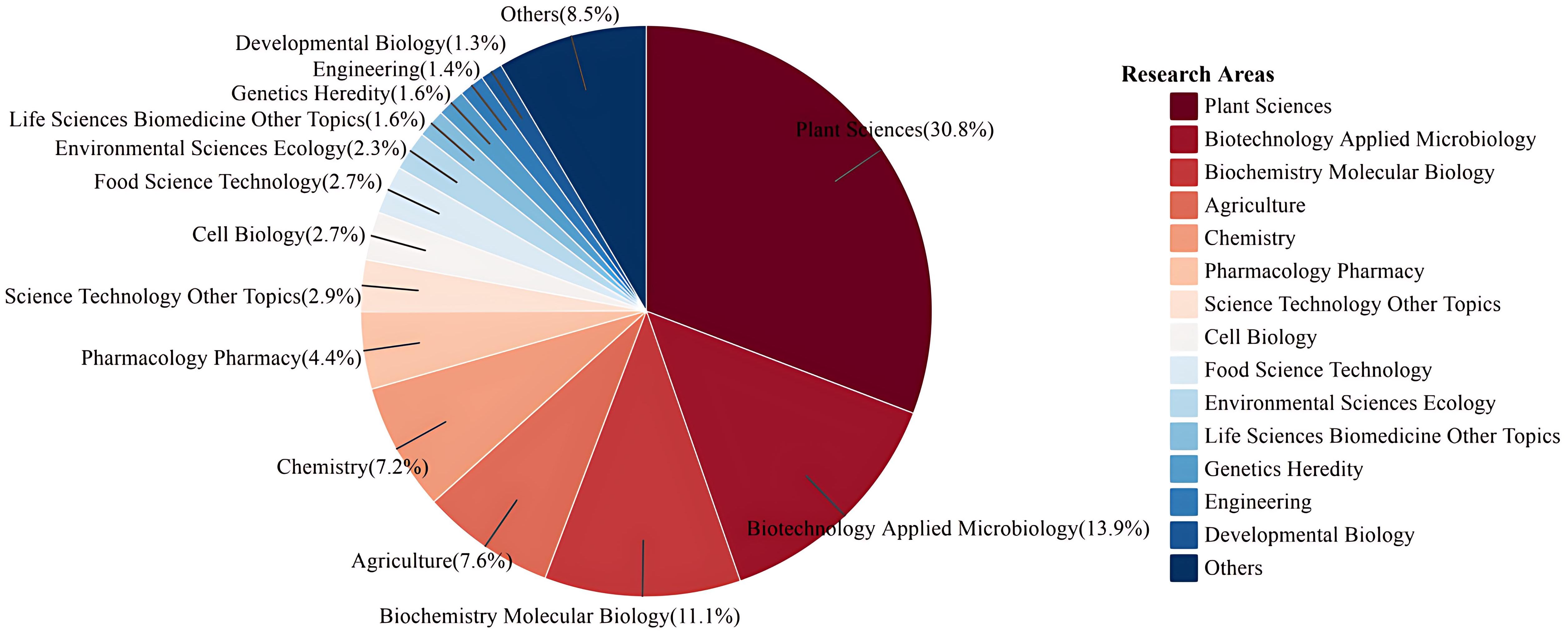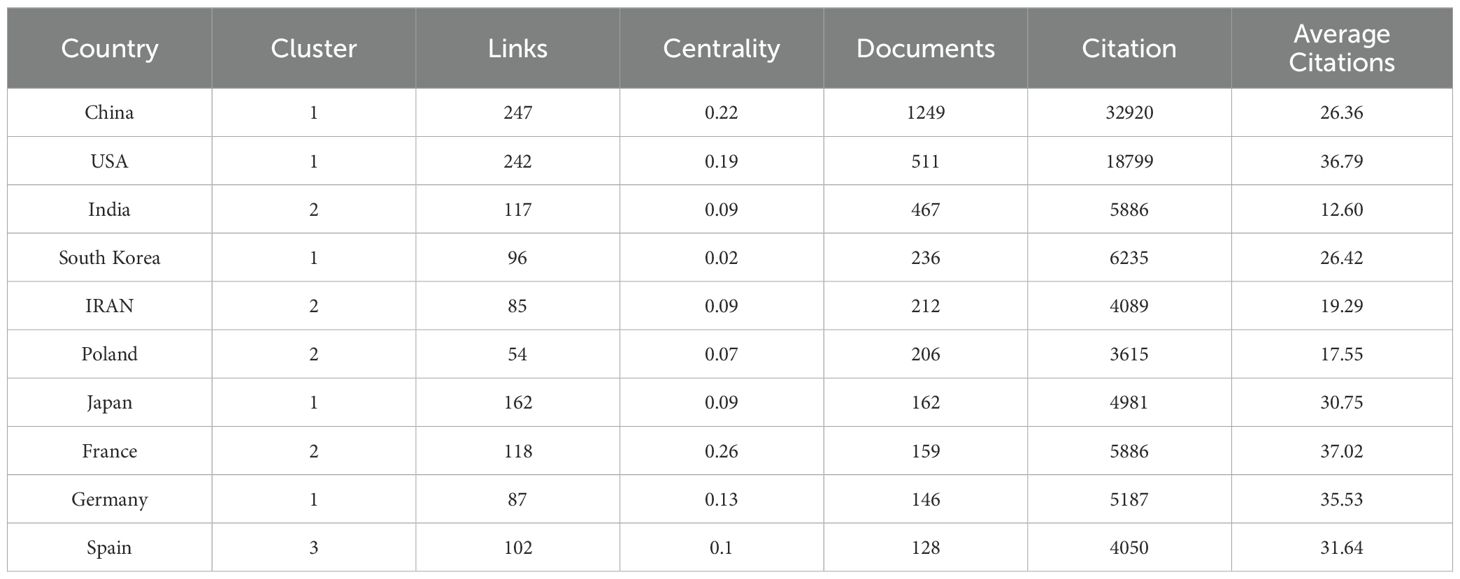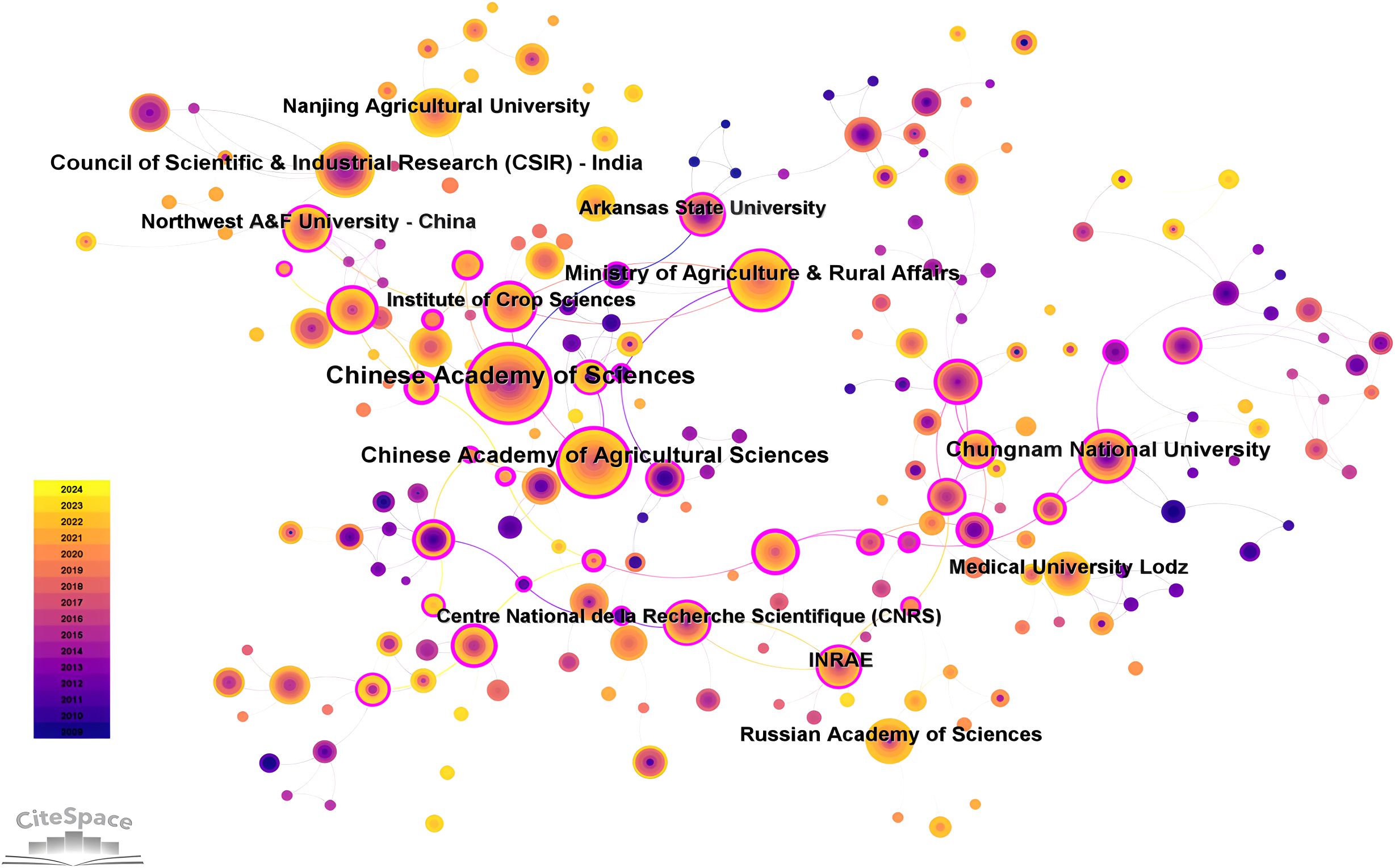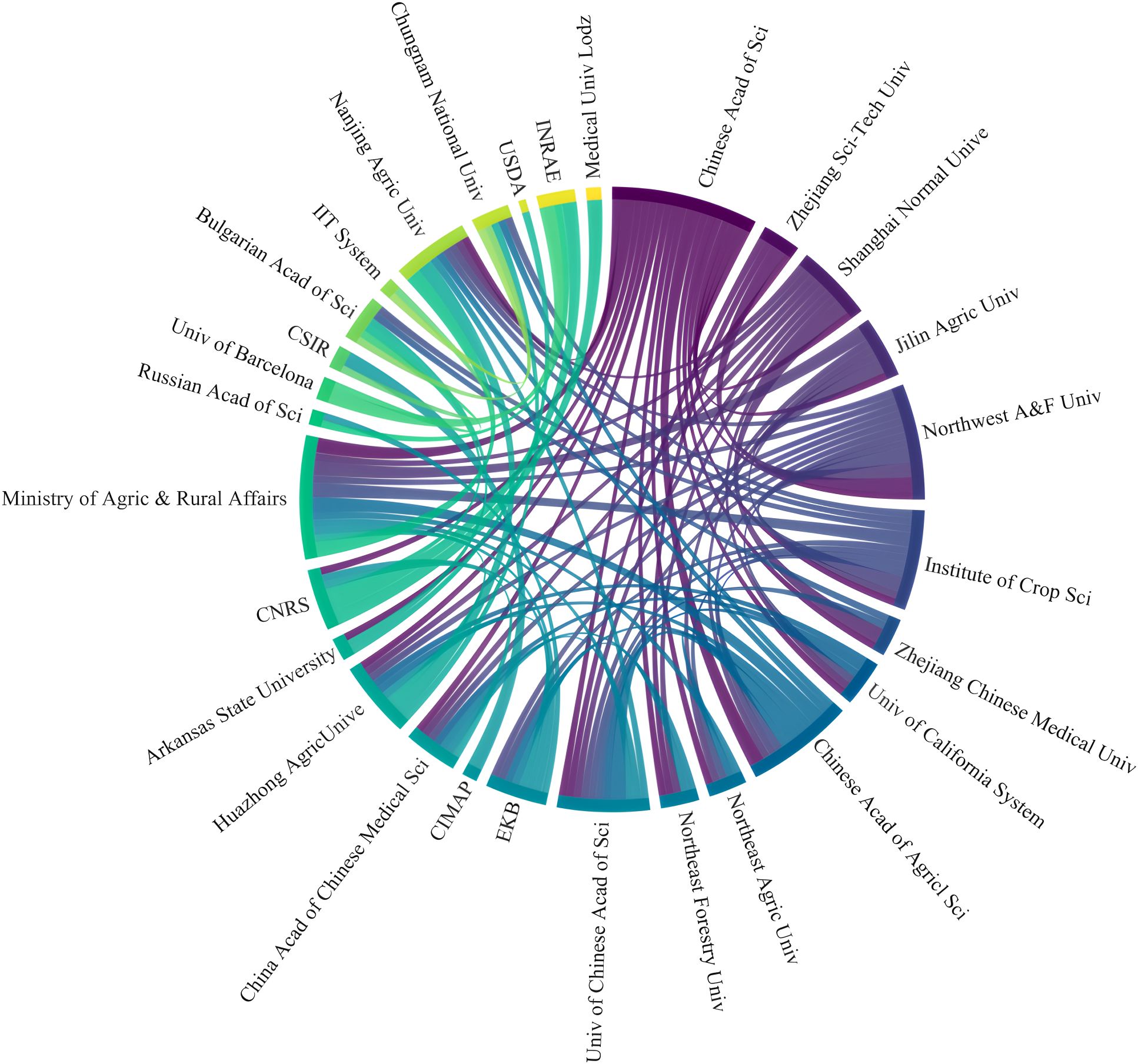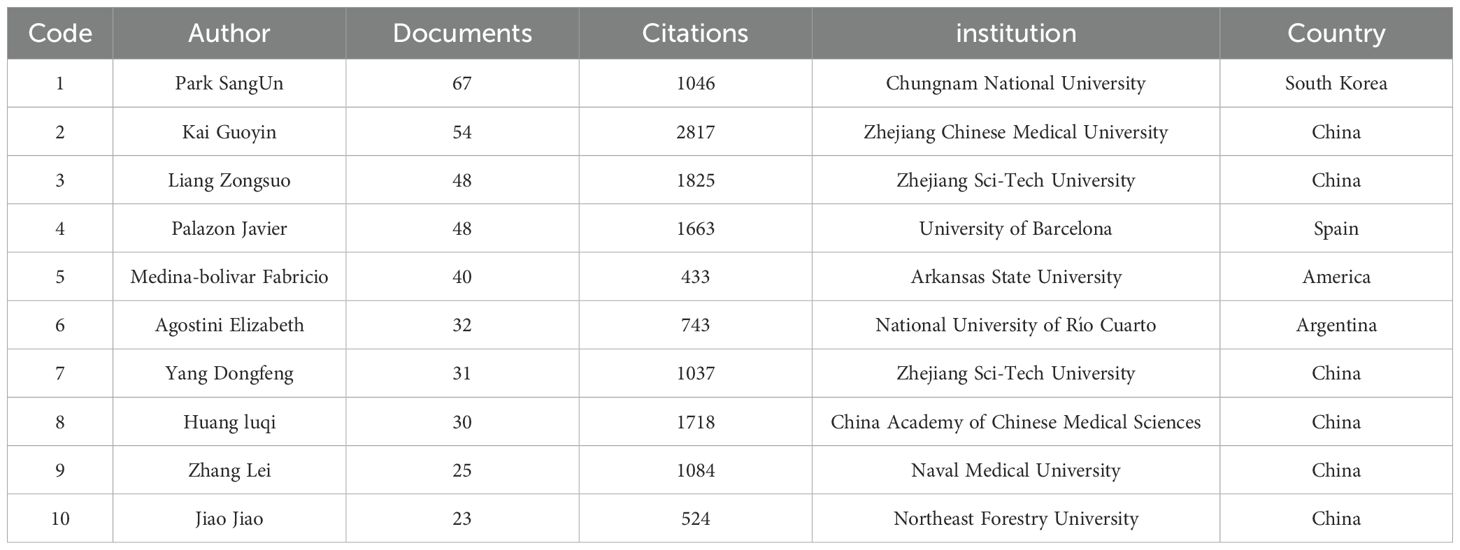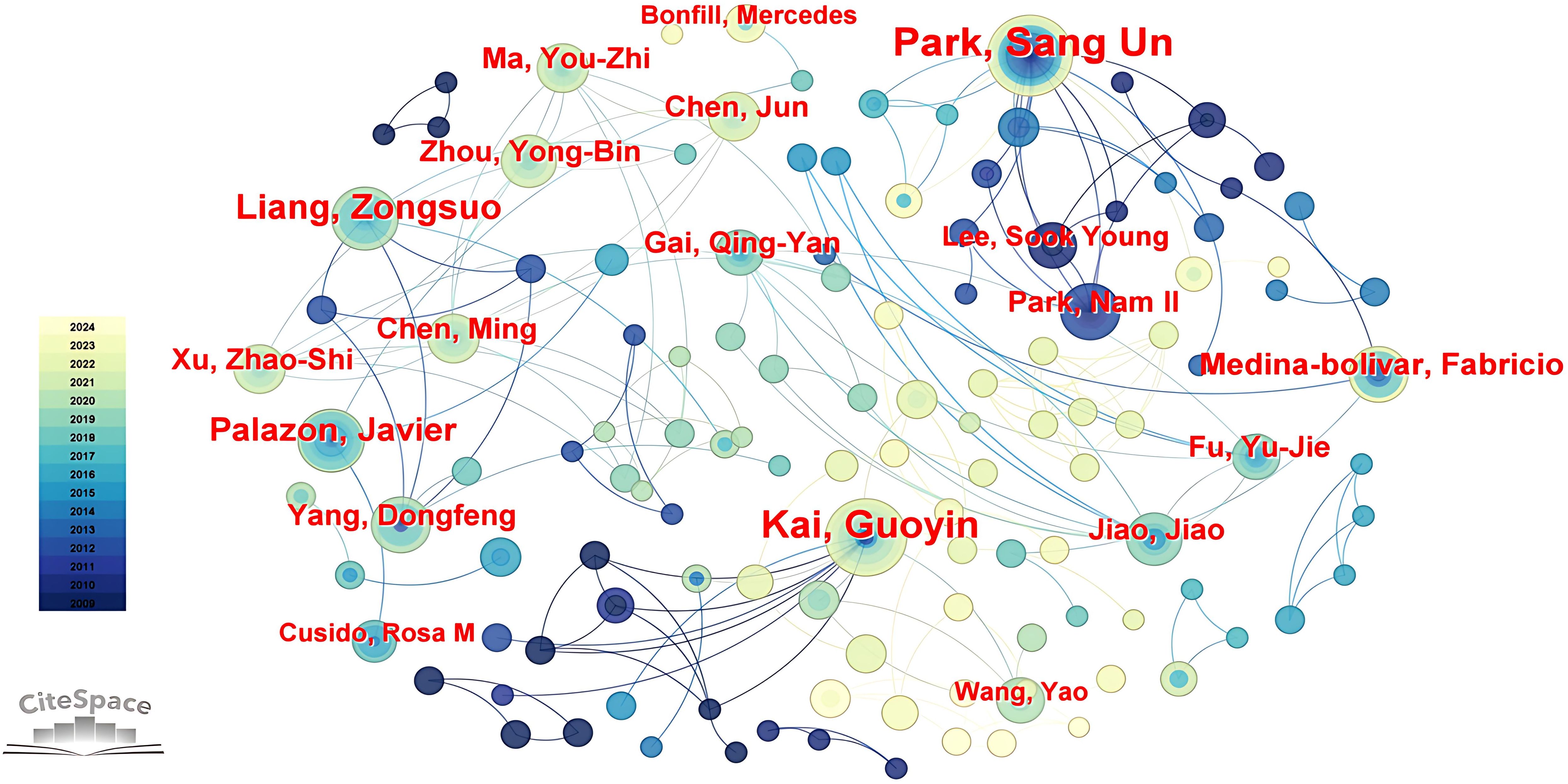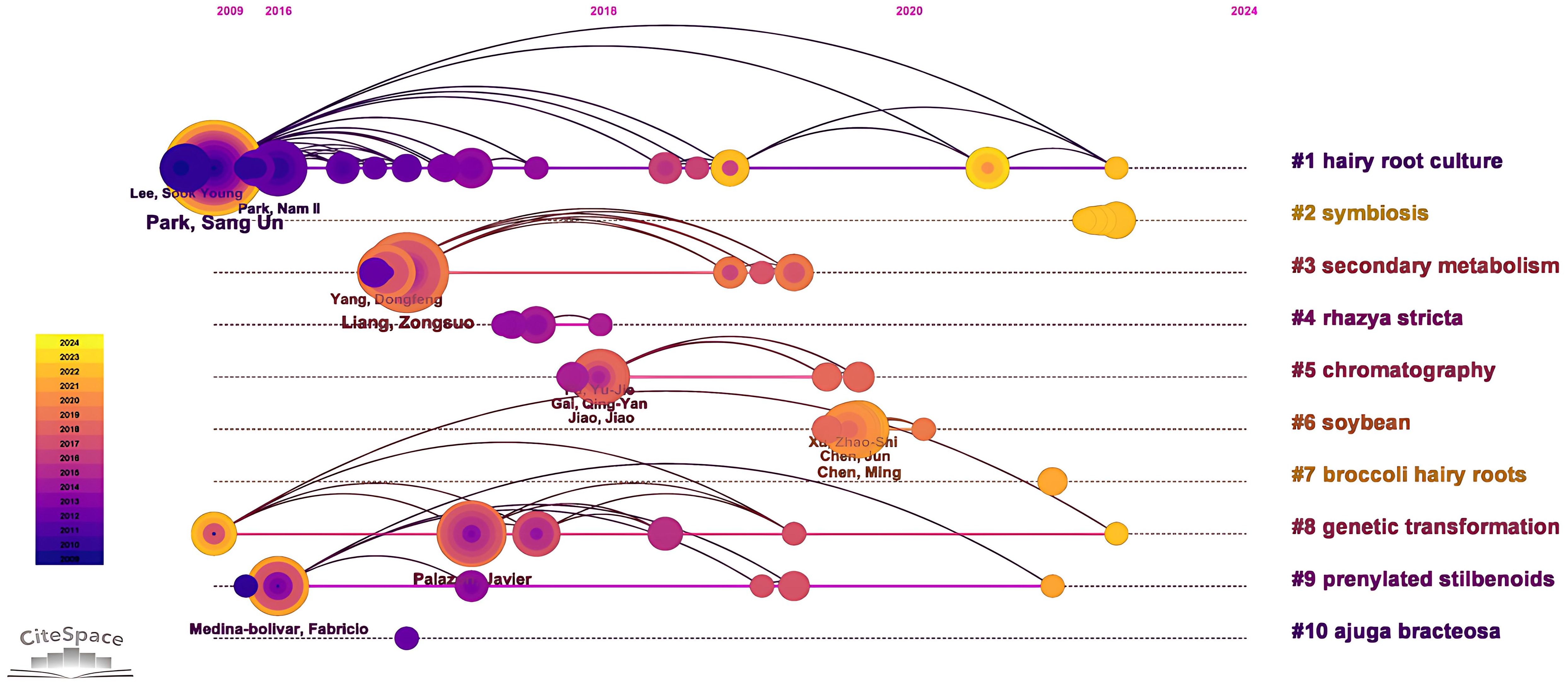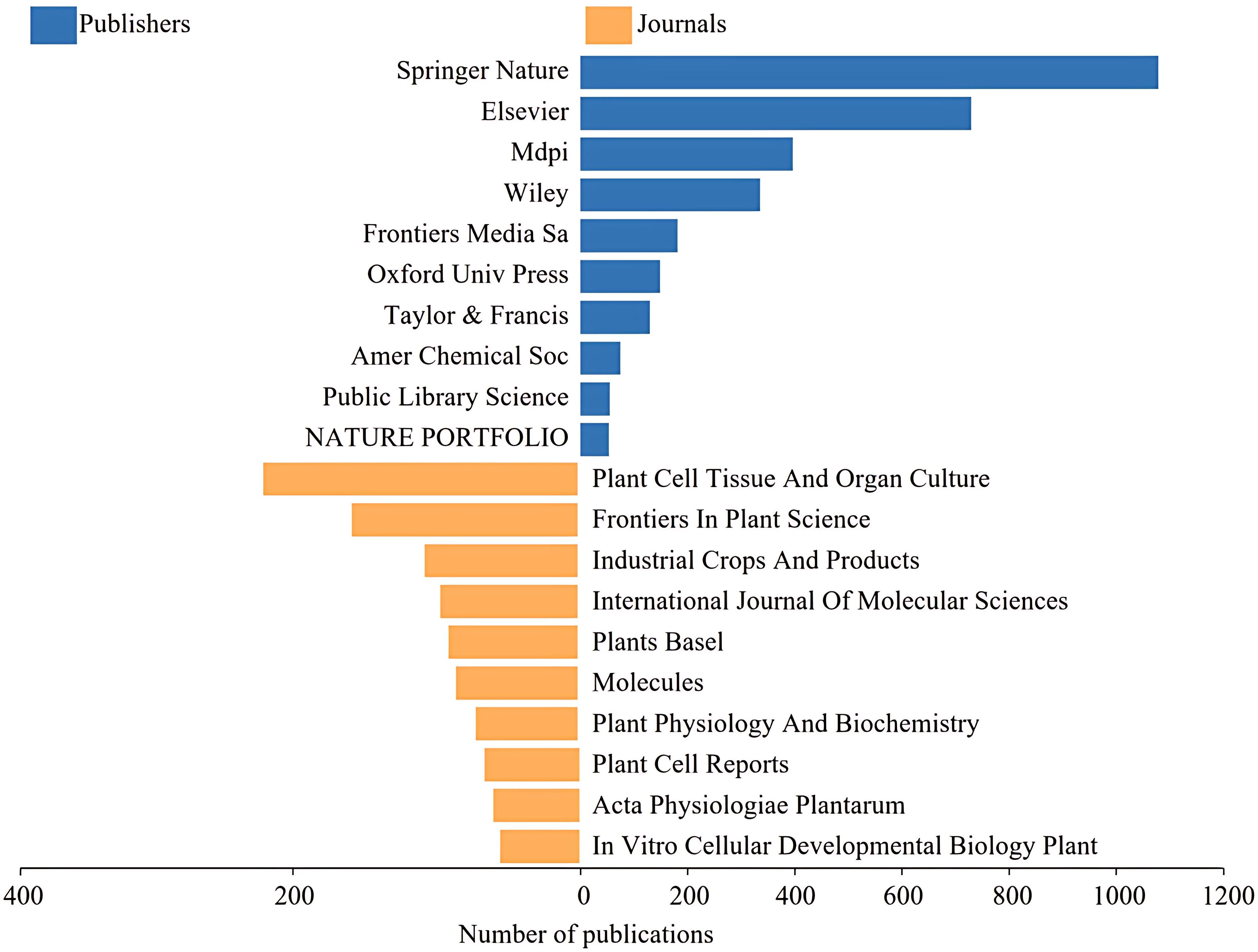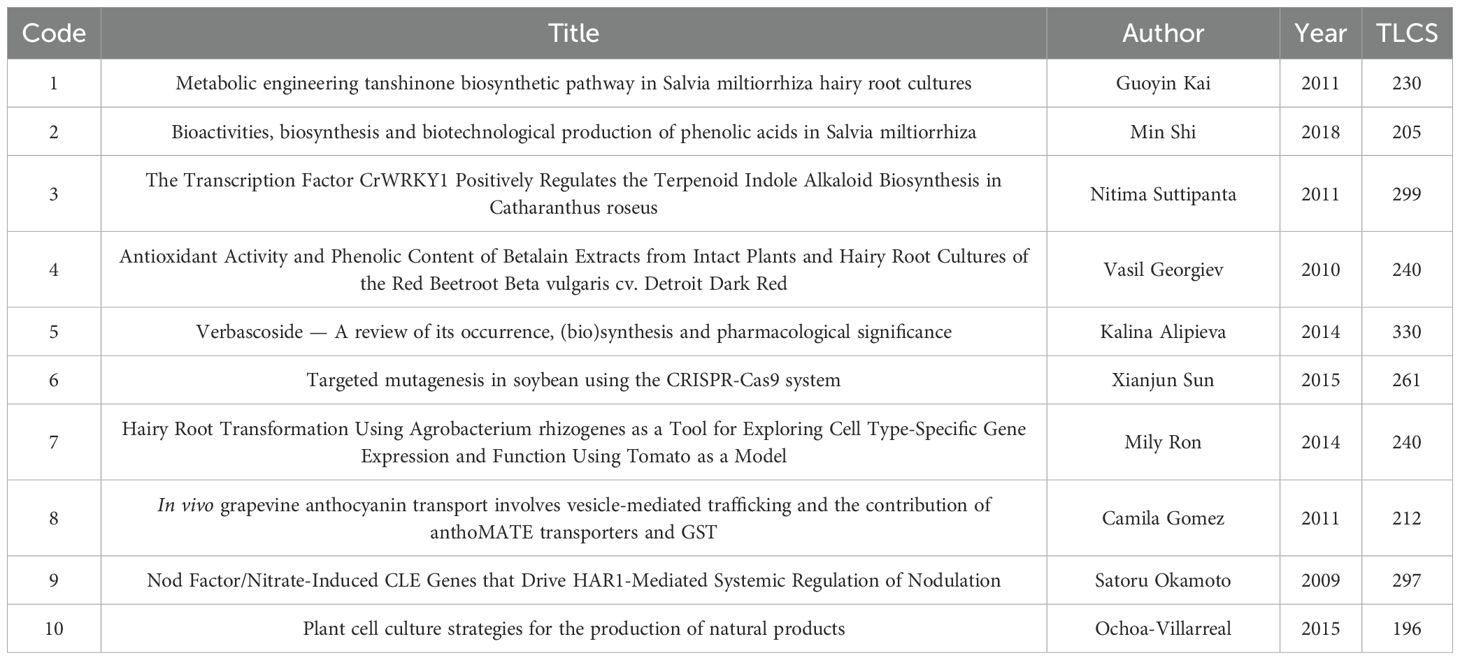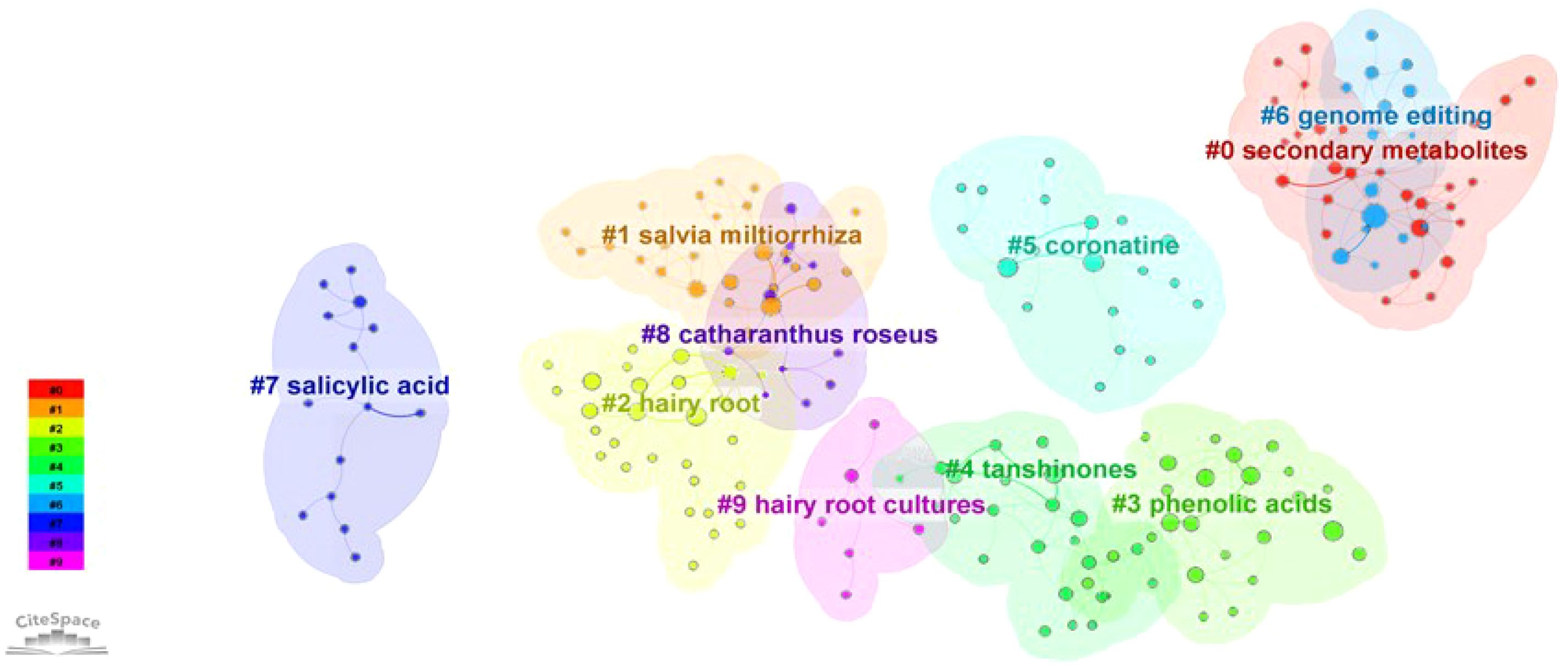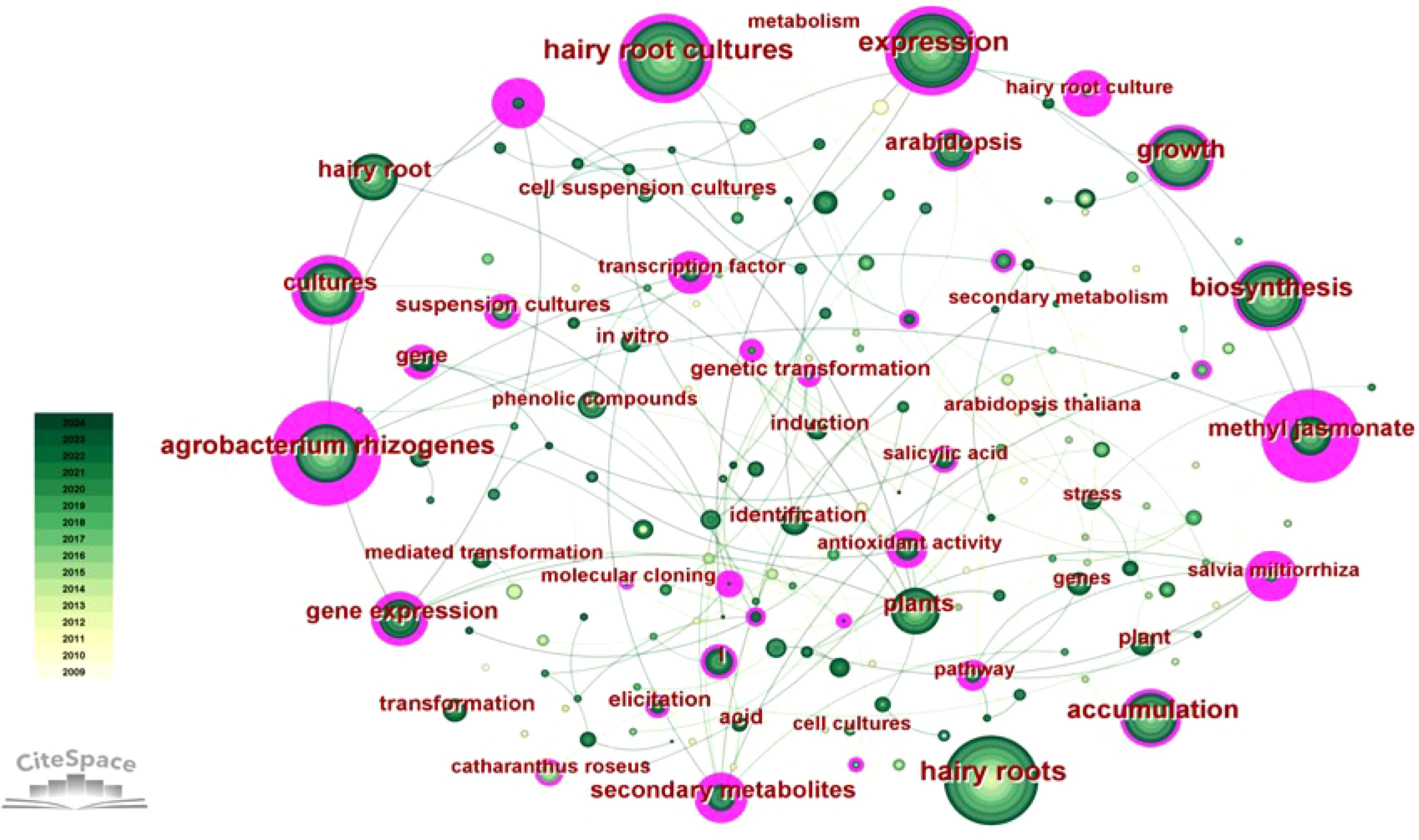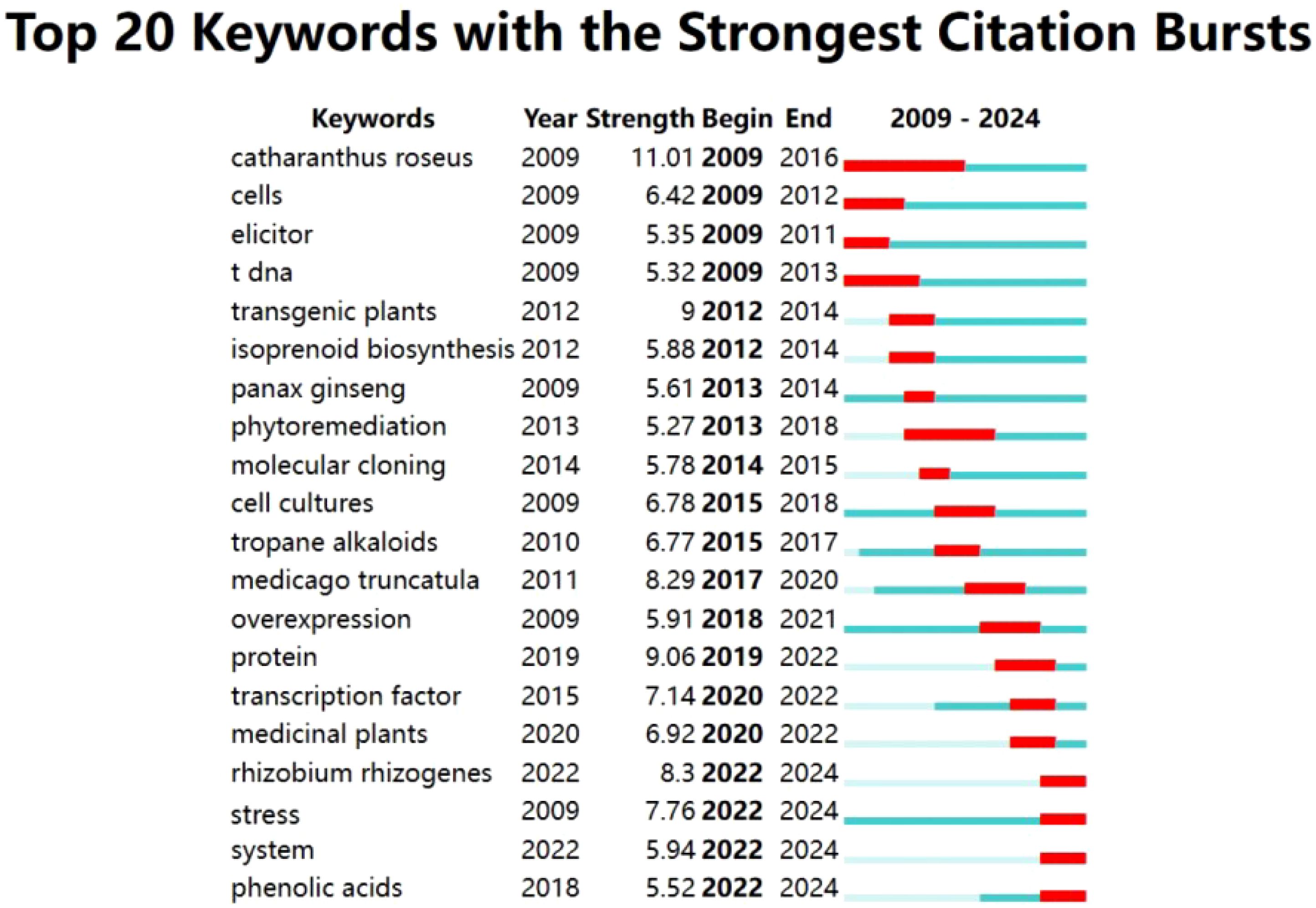- Library of Henan University of Science and Technology, Henan University of Science and Technology, Luoyang, China
Hairy root is a special form of root tissue, which is induced by Rhizobium rhizogenes and could mediate genetic transformation after the infection of explants. They have attracted attentions because of their advantages of fast growth rate, convenient culture, stable genetic properties and strong synthesis ability of secondary metabolites. With bibliometrics, this study employed CiteSpace and VOSvivewer softwares to analyze the publications on hairy roots researches from 2009 to 2024 based on WOS database. The subject distribution, countries, institutions and personnel, research hotspots and research trends of hairy roots were discussed and analyzed. The results revealed a consistent increase in publications on hairy root with America, China and India as the main countries. The institutions were mainly universities and the Chinese Academy of Sciences was a major contributor to this topic and had close cooperation with other institutions. The researches of hairy roots mainly focused on plant genetic transformation, secondary metabolism and gene molecular function analysis, and in environmental remediation. The application of hairy roots could be an important research hotspot in the future.
1 Introduction
With the global population growth and the increasingly complex climate situation (Raihan, 2023), the contradiction between supply and demand of resources has become increasingly prominent, including food, medicine and industrial materials (Dwivedi et al., 2013; Löfgren et al., 2024). Synthetic biology is an effective way to solve scientific and social problems in agriculture and industry, and hairy roots are one of the major biosynthetic tools (Morey and Peebles, 2022; Ye et al., 2023). Hairy root, as a plant pathological phenomenon, is a special form of root tissues mediated by Rhizobium rhizogenes infection of plant wounds (Hu. and Du., 2006). With the characteristics of genetic stability, strong metabolic synthesis ability, convenient culture and short production cycle, plant hairy roots will be developed into an important tool for plant secondary metabolism and industrial biosynthesis (Hu. and Du., 2006; Srivastava and Srivastava, 2007; Gutierrez-Valdes et al., 2020),. Among them, secondary metabolites are considered to be special metabolites, which have a wide range of roles in agriculture, food and medicine (Dixon and Dickinson, 2024). In addition, according to these excellent properties, the application and potential of hairy root in plant function verification and environmental governance will be a research hotspot (Kiryushkin et al., 2021).
As an organized culture system, hairy roots are induced by Rhizobium rhizogenes with integrating T-DNA from Ri plasmid into plant genome for transcription and expression (Guillon et al., 2006; Sykłowska-Baranek et al., 2022). The induction of hairy roots is regulated by multiple factors, including plant species, explant and strain type, transformation method (bacterial concentration and infection time), medium type (rate of plant hormones or chemical inducers) and culture conditions (temperature, photoperiod and pH) (Ferguson et al., 2023; Zhu et al., 2024). Thus, there are many factors influencing hairy root induction, leading to the independence of various plant genetic transformation systems (Ron et al., 2014; Cheng et al., 2021). Hairy root has important applications in plant transformation and synthesis of secondary metabolite, however, there are not systematic analysis and summary of the present research situation about this.
Compared with a literature review, bibliometrics combines mathematical and statistical methods to analyze the quantitative relationship and development regularity of scientific literature, and then summarizes research progress and trends in related research fields (Ninkov et al., 2022; Salinas-Ríos, 2022). The development of bibliometrics benefits from the introduction of software such as Citespace and VOSviewer, which contribute to the analysis of countries, institutions, journals, authors and keywords through network analysis and clustering algorithms (Chen, 2006; Van Eck and Waltman, 2010; Mokhnacheva and Tsvetkova, 2020). The mining and analysis of keywords and co-author information in scientific literature can quickly understand the development, trends and frontier hotspots of this research field, which lays a foundation for the selection of future topics and the cooperation between different institutions (Chen, 2012; Chen et al., 2024). To date, researchers in various disciplines have established several relevant bibliometric analysis; for example, in the field of plant research, the research status and development trend of Impatiens balsamina and Phalaenopsis were described in detail (Guo WenJiao et al., 2017; Chen et al., 2024). In addition, some scholars had summarized the research status and global trends of Slow/Controlled-Release Fertilizers and Soil Carbon Sequestration (El Allaoui et al., 2024; Francis et al., 2024). The study of hairy roots mainly involves classification cytology, molecular biology and genetic breeding, and has made some progress (Aghaali et al., 2024; Ajdanian et al., 2024; Karami et al., 2024). However, there is no scientific and systematic collation and summary of researches in these fields with quantitative analyses.
Based on the academic publications in web of science (WOS), this study conducted a comprehensive quantitative assessment of the scientific literature related to hairy root researches, focusing on the period from 2009 to 2024. By using the method of bibliometric analysis, this article discussed the research status and development trend in the past 15 years, aiming to provide basic scientific basis for the optimization of the basic theory and application system of hairy roots. A visual analysis of scientific literature was constructed with CiteSpace and VOSviewer, and the main goals and contributions of this article are as follows: (1) The number of publications and subject information related to hairy root researches were counted and analyzed to predict the future publication trend; (2) The analysis of the co-occurrence relationship between major groups of hairy root researches, understand the geographical distribution characteristics of the field, highlight cooperation and main research directions, to explore potential cooperation opportunities among researchers; (3) Through citation and keyword analysis, the research progress and hot spot trends in this field were determined, and future research topics are proposed.
2 Materials and methodology
2.1 Data collecting
The retrieval of scientific literature related to hairy roots was extracted based on web of science, which is the largest and most authoritative comprehensive information database (Mongeon and Paul-Hus, 2016). It contains the most influential research literature and is described as one of the most outstanding literature search tools in the world (Vieira and Gomes, 2009). The scientific literature of this topic is limited to January 1, 2009 to December 31, 2024. The starting collecting time is set on January 11, 2024, through “advanced search” of WOS and with “TS = hairy roots” as the searching terms. According to the title and keywords of the article, the search results were further filtered and exported in the format of plain text file. A total of 3935 scientific papers were identified for bibliometric analysis, and the search and analysis flow chart is shown in Figure 1.
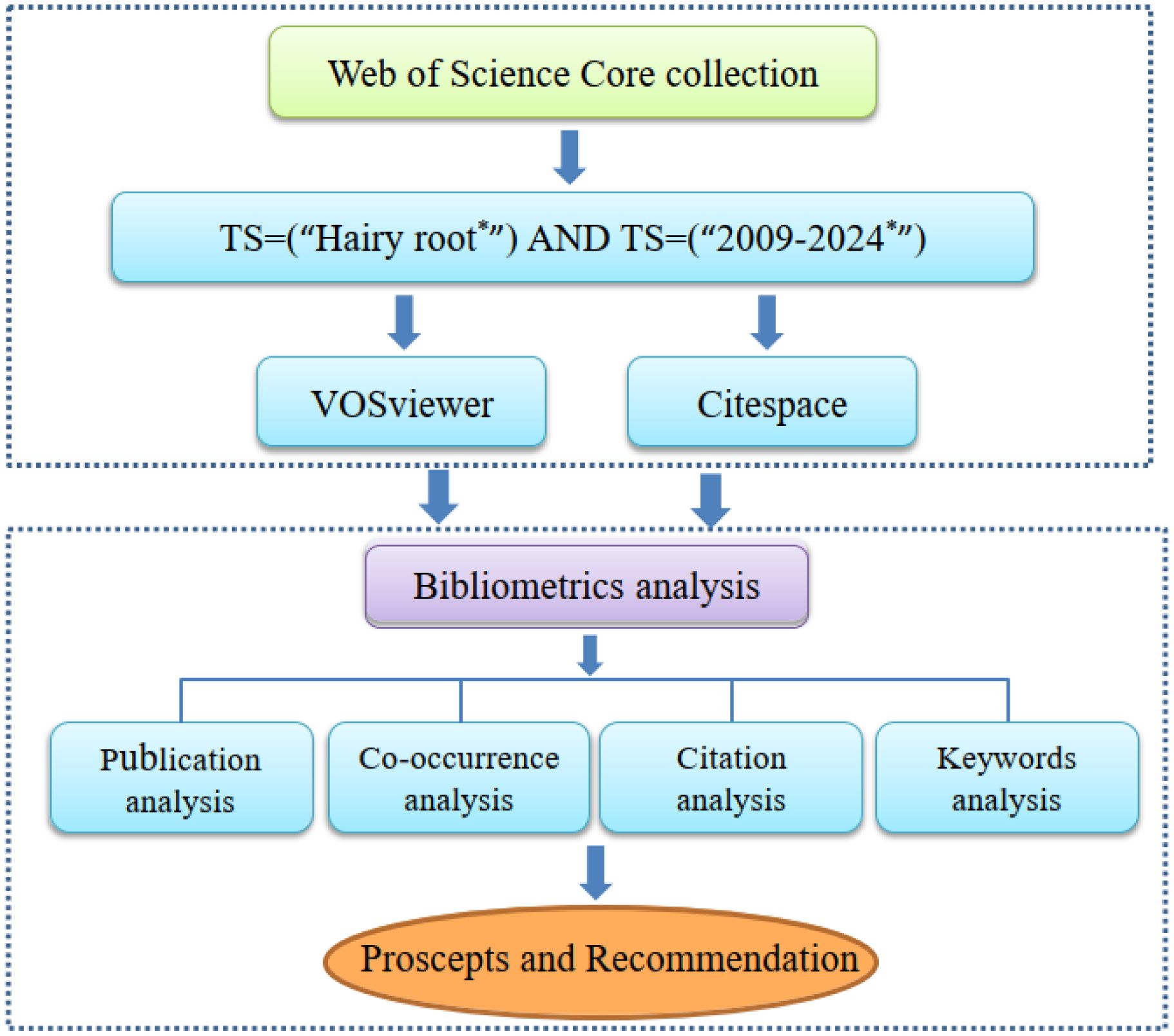
Figure 1. Research working flow chart of this study. ‘‘TS = hairy roots’’ indicated that hairy root was used as the topic for the search and ‘‘TS =2009-2024’’ indicated that the time was span between 2009- 2024.
2.2 Research methods
The CiteSpace (version 6.3.R1) and VOSviewer (version 1.6.20) were employed to visualize and analyze the publications from the WOS database. In CiteSpace, “author”, “country”, “institution” and “keyword” are used as key nodes with “January 2009 to December 2024” as time slices. In the analysis, the picture is simplified by the “pathfinder algorithm” with other default parameters. In VOSviewer, the journal coupling analysis was constructed with node types set as “bibliographic coupling, source”. The online websites ChiPlot and BioLadder are used to create histograms and chords.
3 Results
3.1 Publication information analysis
3.1.1 Publication statistics
Through the retrieval of the WOS database, a total of 3935 non-redundant hairy roots related publications from 2009 to 2024 were used for bibliometric analysis. In general, the description presented in Figure 2 illustrated an increasing trend of scientific literature. According to the number of publications, the study was divided into three stages, as “Initial period” (2009-2017), “Development period” (2018-2021) and “Booming period” (2022-2024). In the initial stage, the number of articles was 1822, with an average of about 202. The number of publications was 275 per year in the development period. Since 2022, the number of publications has increased significantly, reaching about 337 articles per year. Although the number of publications shows a certain decreasing trend in the booming period, it is in line with the research trend of previous years. Generally, these results highlight the growing academic interest of hairy root research.
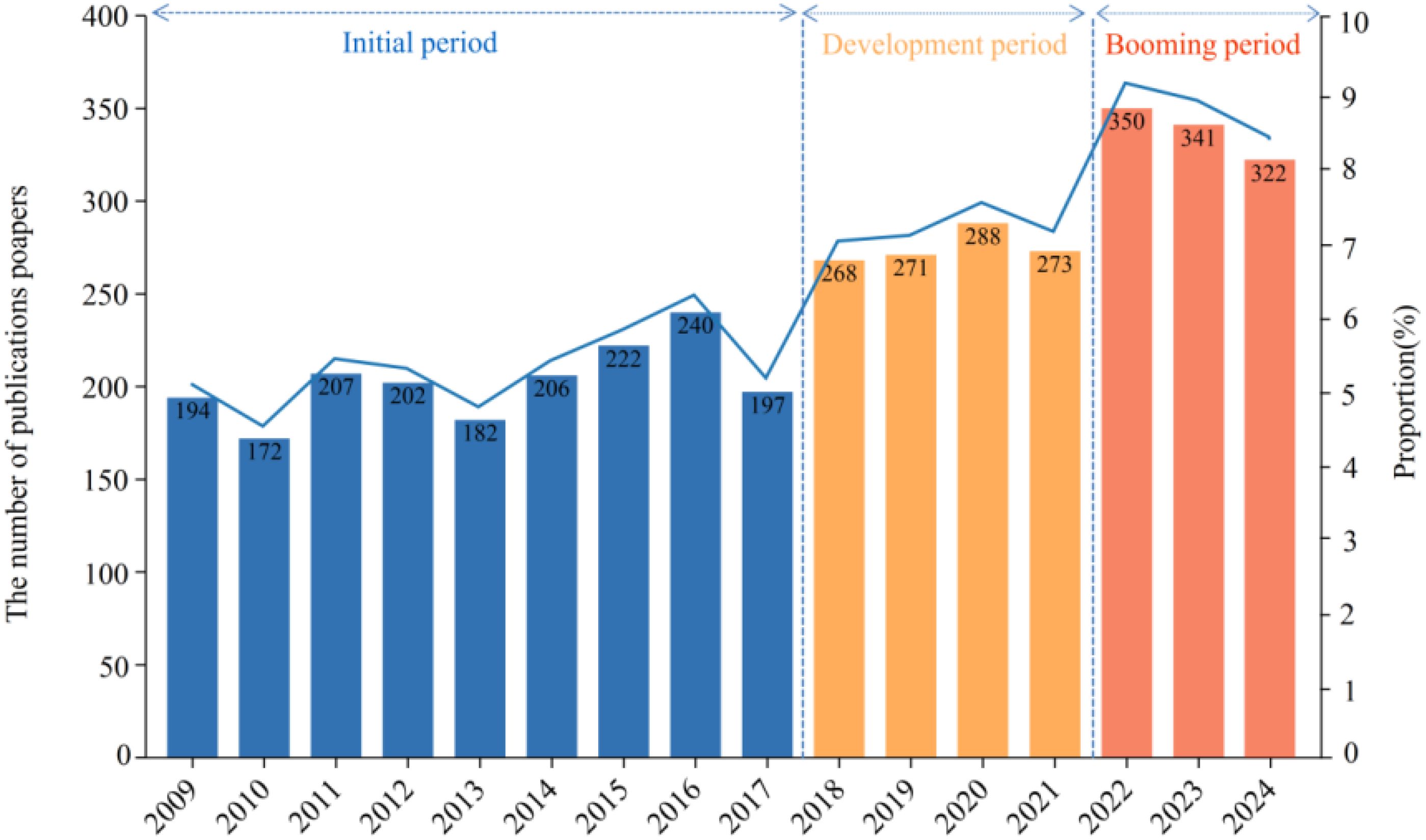
Figure 2. The analysis of annual publication on hairy root researches from 2009 to 2024. The ratio of the annual publication to the total publication is taken as proportion from 2009 to 2024.
3.1.2 Subject categories
The statistics and analysis of the disciplinary involved in the publications related to hairy roots were established Figure 3. Plant Sciences with 1859 articles accounted for the largest proportion, followed by Biotechnology Applied Microbiology (836 articles) and Biochemistry Molecular biology (598 articles). In addition, Agriculture, Chemistry and Pharmacology Pharmacy also have a relatively high proportion, which is a hot field of hairy root research. Thus, the study of hairy roots revealed the characteristics of multidisciplinary structure and diversity in the fields of plant science, agronomy and chemistry (Banerjee et al., 2012; Ludwig-Müller et al., 2014; Morey and Peebles, 2022). These results suggested that hairy root research has the potential to address global challenges and promote the development of agriculture and bio-industry.
3.2 Research profiles
3.2.1 Country contribution
The number and distribution of publications are analyzed based on the country and shown in the Figures 4, 5; Table 1. China has the highest number of publications (1249), accounting for 31.74%, and was the major country, followed by America (511 publications) and India (467 publications). A total of 103 countries participated in the study of this field. Among them, China and USA also have higher centrality values, which illustrated their close cooperation with other countries in this field. In addition, the number of articles in India is high but the centrality is 0.09, indicating less cooperation with other countries. In the national cooperation map of geographic visualization, in Asia, the cooperation between countries is mainly China, South Korea, Japan and India. In North America, such as America and Mexico, cooperation and exchanges are mainly between the countries from European, Asian and South America, including China, Brazil, France and Spain. Among them, China has cooperation with many countries, forming a network of cooperation in Asia, Europe, Oceania and North America. In the field of hairy root research, scientists from different countries should be encouraged to carry out research through interdisciplinary cooperation, sharing resources and technologies.

Figure 4. Distribution and frequency analysis of hairy roots in geographical regions. The size of the circle indicates the number of articles and the purple outer circle indicates the centrality.
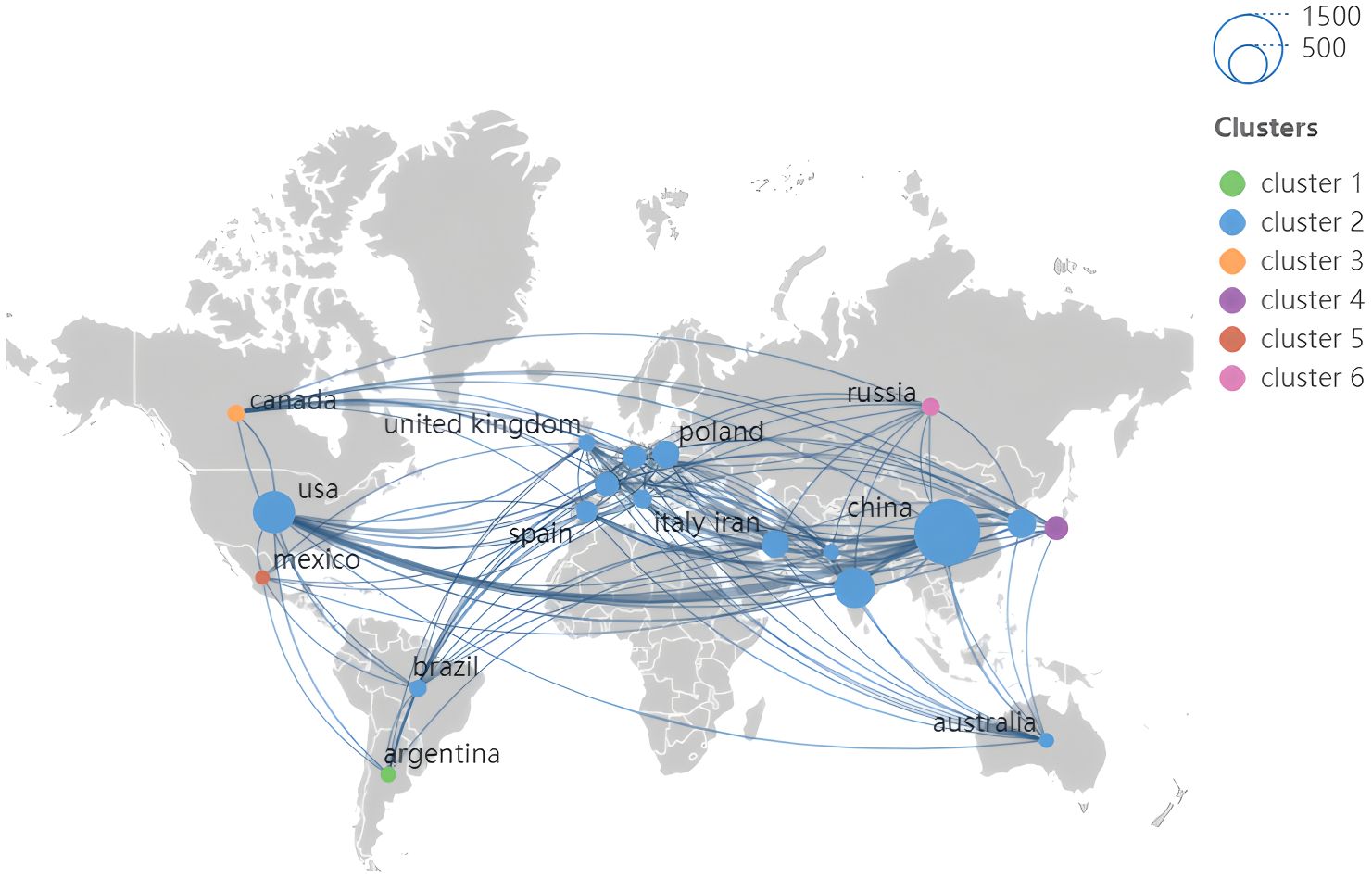
Figure 5. Geographical distribution analysis of national cooperation network based on publication output. The magnitude of the circle represents the number of articles and different colors represent countries in different clusters with the intensity of cooperation.
3.2.2 Contribution of the institutions
Statistical analysis revealed that a total of 288 institutions from 103 countries published articles related to hairy roots Figure 6. And among the top ten institutions in the number of articles, five are in China, and the others are in India, South Korea, Russia, Poland and France, respectively. The Chinese Academy of Sciences had the largest number of articles (165, accounting for 4.19%), followed by Chinese Academy of Agricultural Sciences (109 articles), Council of Scientific & Industrial Research (88 articles) and Ministry of Agriculture & Rural Affairs (88 articles). Furthermore, among the top ten institutions, Chinese Academy of Sciences, Chungnam National University and INRAE have high centrality, indicating more collaboration with other institutions. In addition, the cooperation between institutions in the WOS database is generally established in the same country, and there is less external communication. The cooperation relationship among 29 institutions with more than 30 publications was shown in Figure 7. For institutions, cooperation in the field of hairy root research is limited, and the Chinese Academy of Sciences has a broader cooperation relationship with other institutions. An enhanced cooperative relation of institutions is essential for the study of hairy roots.
3.2.3 Author collaboration
The top 10 authors in terms of the number of publications are shown in Table 2 and the top researchers are mainly Park SangUn (67 articles, Chungnam National University), Kai Guoyin (54 articles, Zhejiang Chinese Medical University) and Liang Zongsuo (48 articles, Zhejiang Sci-Tech University). The cooperative relationship between the authors was further analyzed in Figure 8, Kai Guoyin, Xu ZhaoShi and Chen Ming have collaborated more closely with other authors. In general, there is relatively little cooperation and communication between different authors.
According to keyword clustering, a timeline diagram of author collaborative was constructed Figure 9, and the study of researchers on hairy roots mainly focused on the fields related to hairy root culture, secondary metabolism and genetic transformation (El-Esawi et al., 2017; Xue et al., 2024). Among them, Xu Zhaoshi paid more attention to the study of hairy roots in soybean field. On the whole, there are some differences in the topics of hairy root research among the authors of different institutions. These results indicated that hairy root research has a multidisciplinary structure and diversity, and researchers should integrate resources and technologies in different fields to promote the research and application of hairy roots.
3.2.4 Journal analysis
Further analysis of the sources of publications from the WOS database Figures 10–12, the publishers with the largest number of articles on hairy root research are mainly Springer Nature, Elsevier, Mdpi, Wiley and Frontiers Media Sa. Besides, according to the number of publications, the top-ranked was Plant Cell Tissue and Organ Culture, accounting for 4.19%, followed by Frontiers in Plant Science, Ndustrial Crops and Products. The above journals mainly involve the field of plant science, focusing on plant physiology.

Figure 10. The major publishers and publication titles for hairy roots from 2009 to 2024. The doughnut diagram represents the type and proportion of the publication title, and the internal pie chart represents the type and proportion of the publisher.
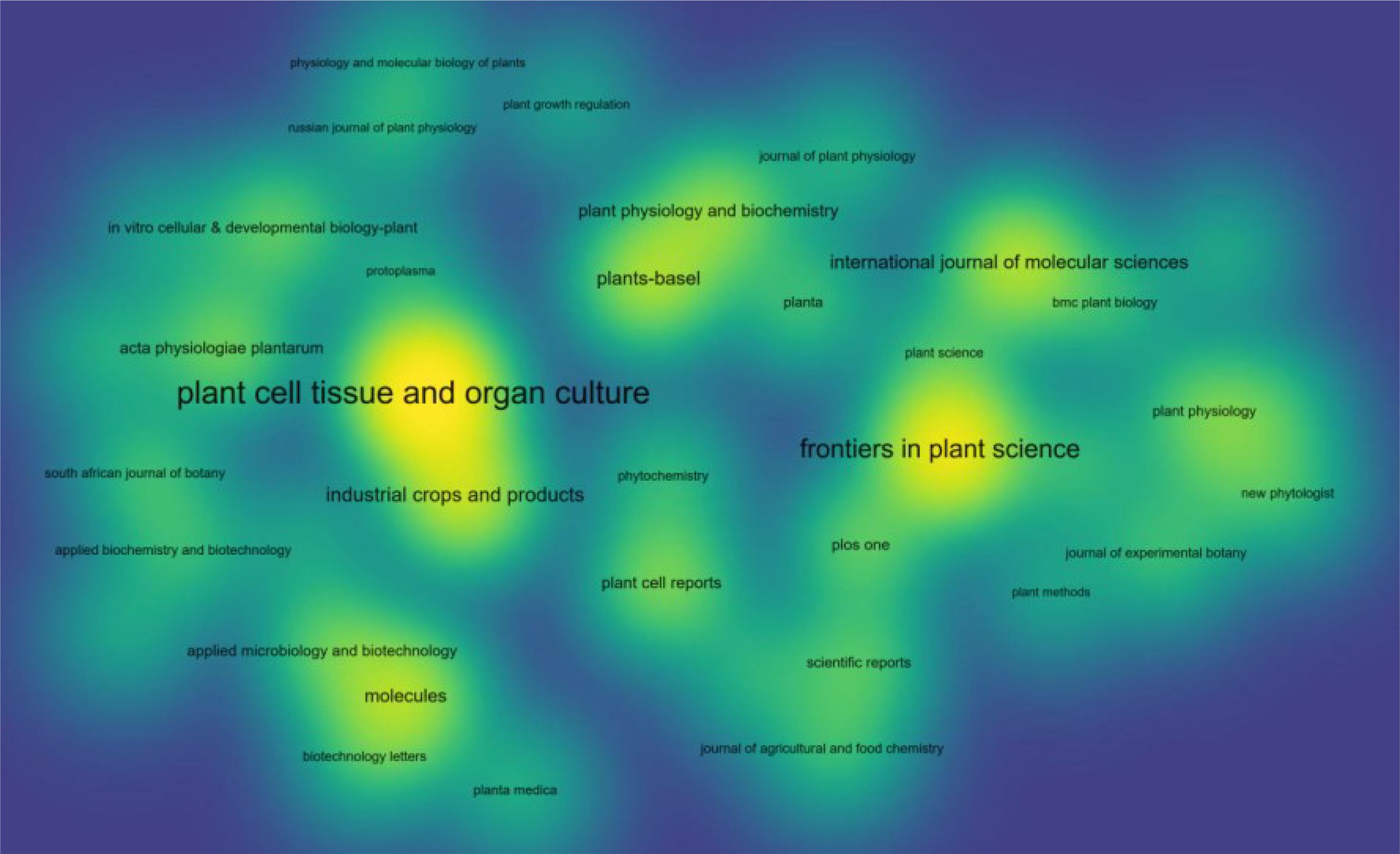
Figure 12. Density plot of coupling analysis of journal citations in hairy root research. The node size represents the number of publications in the journal.
3.3 Research hotspot and trend
3.3.1 The most cited publications
Ranking these publications by citation frequency and finding that the most cited articles are mainly related to research such as plant science. The information of the top ten most cited publications is listed in Table 3. The most cited publications were mainly related to genetic transformation and secondary metabolic synthesis. Further, a cluster analysis of these articles was established based on keywords, and they were divided into 9 clusters, including assalicylic acid, salvia miltiorrhiza, coronatine, secondary metabolism, genome editing and hairy root culture (Figure 13). The above results indicate that the study of researchers on hairy roots focuses on genetic transformation, stress response and secondary metabolism.
3.3.2 Keyword analysis
As a condensed summary of the article, keywords are the main direction of the research content and can be used as a key indicator to identify related research. In CiteSpace, a collinear network of keywords for all publications related to hairy root research was constructed as Figure 14. A total of 5 keywords with a frequency greater than 500 were retrieved, including hairy roots, hairy root cultures, expression, growth, agrobacterium rhizogenes. In addition, the five keywords with the highest centrality were secondary metabolites, gene expression, accumulation, hairy root cultures, agrobacterium rhizogenes. These keywords with high frequency and centrality reveal the theme and development direction of hairy root research.
3.3.3 Analysis of burst words
As shown in the Figure 15, in CiteSpace, keywords were further analyzed through the burst analysis function to predict potential research fronts. During the period from 2009 to 2014, the keywords mainly included T-DNA, cells and elicitor, which indicated that the research on hairy roots during this period focused on the induction of hairy roots. In the next stage (2012-2018), the key words of hairy root research mainly include transgenic plants, cell cultures and tropane alkaloids, indicating that hairy root research has transitioned to scientific application. Since 2018, high-intensity burst words include overexpression, protein, transcription factor and genes. This change indicates that researchers have focused on the relationship between hairy roots and the molecular mechanism of plant functional genes.
To further explore the potential trends in the field of hairy root research, the keywords of the literature from 2022 to 2024 were analyzed Figure 16. These keywords are mainly related to genetic transformation and substance synthesis, including secondary metabolism, genes, elicitation, transform, flavonoids and biosynthesis. The keywords with collinearity indicate that the research in the field of hairy roots has been closely related to genetic transformation and secondary metabolism in recent years. Among the publications related to hairy root research in the past three years, 178 and 121 references 1 were related to genetic transformation and compound synthesis, respectively. Combining the analysis of burst words, the verification of plant functional genes through hairy root-mediated genetic transformation system and the synthesis of secondary metabolites are the current and future research hotspots.
Furthermore, based on the WOS database, the contribution of hairy roots in genetic transformation and secondary metabolism research was analyzed. We only focused on the top fifteen species in the most cited publications. As shown in Table 4, as a traditional medicine, the genes and pathways related to secondary metabolism in hairy roots of Salvia miltiorrhiza are described in detail, and the genetic transformation mediated by hairy roots provides a strategy to solve the content limitation of main compounds in Salvia miltiorrhiza. In addition, researchers have also focused on the application of hairy roots in other plants, including Catharanthus roseus, Echinacea purpurea, and L. album. Therefore, the hairy root system can be established by Rhizobium rhizogenes to realize the industrial production of secondary metabolites and solve the problem of market demand in the future.
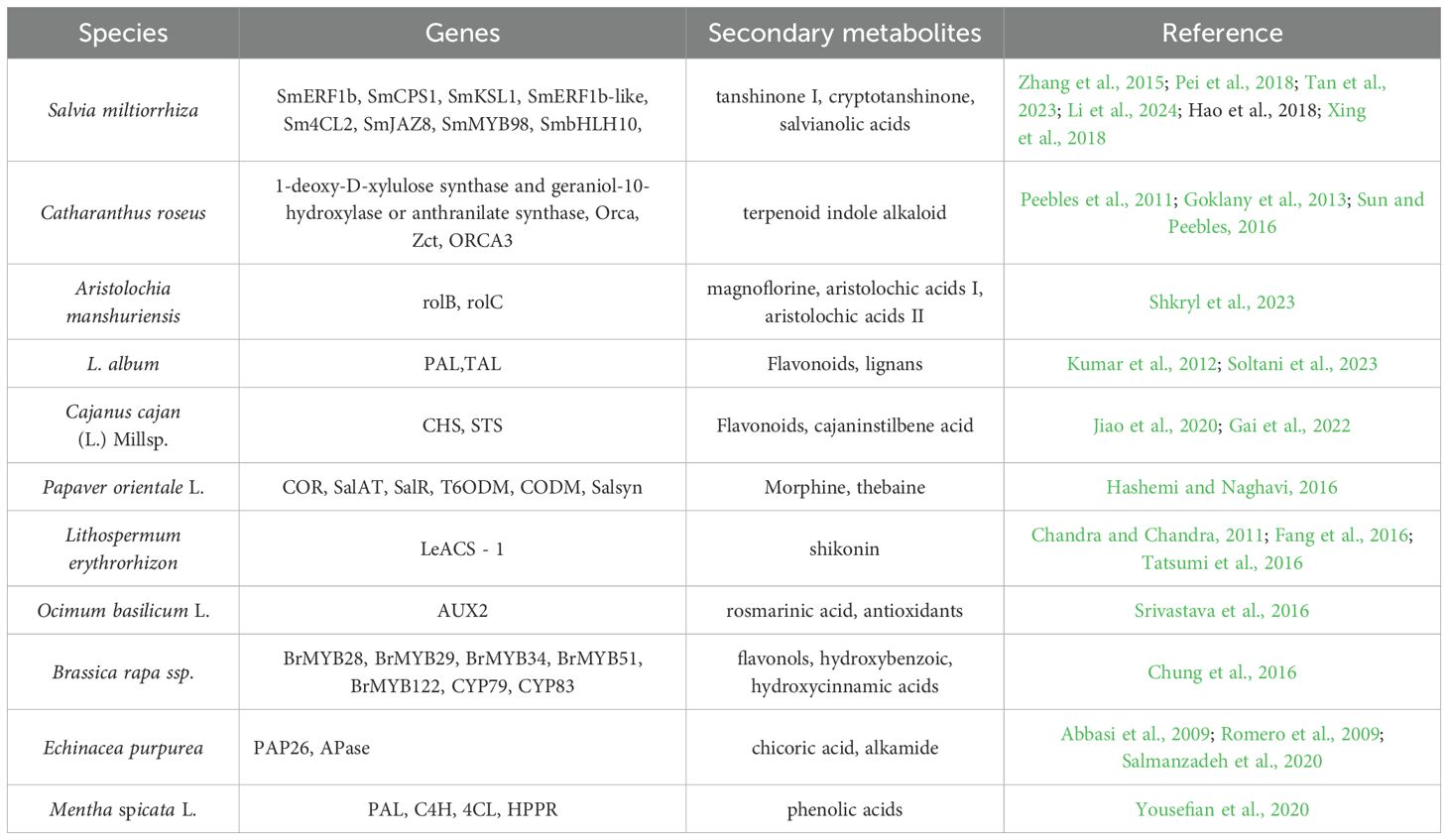
Table 4. Analysis of genetic transformation and secondary metabolic publications based on hairy roots.
4 Discussion
4.1 Overview of hairy root research based on WOS database
The results described the research progress of hairy root-related publications, including the progress in the number and impact of publications, as well as the collaboration network between specific countries, institutions and authors. By analyzing the co-occurrence of keywords, the changes in the pattern of hairy root research and its potential to provide information for future research were revealed. As the data revealed, the research field of hairy roots was expanding rapidly, which explained the attention of researchers to hairy roots and its potential for future science and production.
A major result of bibliometric analysis was the high level of collaboration in hairy root research. The research center was mainly located in the countries of China and Western Europe. Among them, China, America, Spain, Australia and Brazil have established intensive cooperation networks and expanded their research fields from Asia to Europe, North America, South America and Oceania. This interconnection not only contributes to the sharing of research resources, but also promotes interdisciplinary innovation, and accelerates the dissemination of knowledge through cooperation in different regions (Salmerón-Manzano et al., 2020; Taghouti et al., 2022). In this field, cooperation between different institutions was mainly established in the same country or region. The Chinese Academy of Sciences was a major contributor to the study of hairy roots. It not only had a high number of publications, but also has close cooperation with institutions in different countries. The close collaboration between the countries was supported by the growth of shared technologies, and this global partnership enables researchers to gain access to hairy root applications in a wider range of plant species.
In addition, the trend in the field of hairy root research was increasingly turning to genetic transformation techniques, secondary metabolic synthesis and verification of plant functional genes. Rhizobium rhizogenes-mediated hairy root transformation methods have continuously completed the establishment of genetic transformation systems in various plants, which had greatly promoted the development of plant science (Brijwal and Tamta, 2015; Qin et al., 2021).
Although this study provided valuable insights into the global trend of hairy root research, there were inherent limitations in bibliometric analysis. One of the main limitations was that the study was only based on the WOS database, and the scope of the database used for analysis was very limited, excluding other related studies available in databases with unique advantages, including PubMed, Google Scholar, and CNKI Database. In particular, non-English publications may be neglected, which potentially limits the global diversity of literature, which may lead to research results biased towards regions dominated by English publications (Pranckutė, 2021; Bakhmat et al., 2022).
4.2 Research prospects of hairy roots
Since 2009, the focus of research in the field of hairy roots has shifted from hairy root culture to secondary metabolism, plant genetic transformation, medicinal plants and molecular functions. The application of hairy roots focuses on plant genetic transformation, environmental remediation and secondary metabolite accumulation, and plant genetic transformation serves the study of medicinal plants. Broadly speaking, medicinal plants include plant resources used as nutritional agents, certain hobbies, condiments, pigment additives, and pesticides and veterinary drugs with special secondary metabolites.
For medical workers, the results of this study highlighted the potential for medicinal plants to become more widely integrated into healthcare. In recent years, increasing attention to bioactive compounds has shown that plant extracts can play a key role in complementary and integrated medicine as a natural substitute for synthetic drugs (Vichakshana et al., 2022; Abdallah et al., 2023; Hao et al., 2020). To date, the development of medicinal plants is faced with the shortage of plant resources, and the research of hairy root technology can maximize the yield of bioactive compounds and ensure the sustainability of development (Jachak and Saklani, 2007; Li and Wang, 2021; Chaachouay and Zidane, 2024). In addition, although the number of publications in China, America and India dominates, the potential of biodiversity-rich regions, such as parts of Africa and South America, in the study of medicinal plants and hairy roots is not fully utilized. From the perspective of decision-making, by providing funds and encouraging international partnerships, it can contribute to the local economy and globalize research objectives (Azwanida, 2015).
In recent years, with the rapid development of gene editing technologies such as CRISPR-Cas9, the application potential of hairy root system in metabolic engineering, functional genomics and medicine development has been further released, showing unique advantages and broad prospects (Cai et al., 2015; Niazian et al., 2022). Hairy roots naturally have the ability to synthesize a variety of high-value secondary metabolites (such as alkaloids, terpenoids, and phenolic compounds), but their yield is often limited by the expression level of endogenous genes (Yousefian et al., 2020; Li et al., 2024). Gene editing technology can significantly increase the accumulation of target products by targeted knockout of inhibitors in metabolic pathways or activation of key rate-limiting enzyme genes (Jedličková et al., 2024). The combination of genetic plasticity of hairy roots and gene editing technology provides an ideal chassis for synthetic biology, and can also accelerate functional genomics research and break through the limitations of traditional breeding (Cheng et al., 2021). Despite the great potential, the application of gene editing in hairy roots still faces technical bottlenecks, such as species dependence of editing efficiency, complexity of multi-gene synergistic regulation, and maintenance of metabolite stability in large-scale culture. The above problems need to be solved urgently to further improve the accuracy and industrialization feasibility of the hairy root system.
Furthermore, the problems of global environmental pollution and ecological balance destruction have become increasingly prominent, and hairy roots have shown considerable potential in environmental stress (Khin et al., 2012; Agostini et al., 2013). Compared with traditional remediation methods, bioremediation has the advantages of safety, low cost, reusability and easy operation. Hairy roots have significant effects in the field of environmental remediation, especially in the enrichment of heavy metal elements, adsorption of phenolic compounds, and removal of nitrogen-containing dyes (Zhou et al., 2013). For example, the accumulation of cadmium in the hairy roots of rape increased with the increase of cadmium concentration, indicating the characteristics of enrichment of heavy metal cadmium, which can be used as an excellent cadmium tolerance test material for cadmium enrichment. In tomato, hairy roots can effectively adsorb and remove phenols from water. In summary, the application of hairy roots in the field of environmental remediation has made some progress, and future research in this area will receive more and more attention (González et al., 2008; Dixon and Dickinson, 2024).
Although the industrialization of hairy roots is still subject to some limitations, the optimization conditions of hairy roots of different species vary greatly; susceptible to bacterial or fungal contamination during long-term culture; efficient extraction of metabolites from complex root tissues requires additional steps and costs; the market demand for high-value metabolites (such as anti-cancer drugs) is limited, while the production of bulk chemicals tends to choose lower-cost systems. Hairy roots have advantages in saving land resources, growth rate and the ability to synthesize secondary metabolites. Combined with the interdisciplinary technology integration, it will continue to overcome the limitations in the process of industrialization.
5 Conclusion
The increasing importance of hairy root research has been described, especially their potential in drug synthesis, therapeutic applications and environmental remediation. Based on the WOS database, this study makes a bibliometric analysis of 3935 papers published from 2009 to 2024, and discussed the research development, hot spots and frontier trends in this field. The main conclusions were as follows: In recent decades, the study of hairy roots had shown a slow growth trend, with 3935 articles published from 2009 to 2024. Asia and Western Europe were the centers of hairy root research. Among them, China, America and India dominate the publication output, and China had established cooperative relations with many countries in South America, Europe, Oceania and Asia. The research institutions were mainly universities, and the Chinese Academy of Sciences was the major research institution, but the cooperation between different institutions needs to be strengthened. Park Sang Un, from Chungnam National University, was the author of the most publications, with 67 articles. The study of hairy roots was more and more inclined to the study of gene and molecular function, including plant genetic transformation. Secondary metabolism was another important research direction. In addition, the potential of hairy roots in medicinal plants and environmental restoration has also attracted the attention of researchers, but it was essential to strengthen the cooperation among global hairy root researchers, deepen the research results and expand the depth of research directions.
Data availability statement
The original contributions presented in the study are included in the article/supplementary material. Further inquiries can be directed to the corresponding author.
Author contributions
Y-PZ: Conceptualization, Data curation, Formal Analysis, Investigation, Methodology, Validation, Visualization, Writing – original draft, Writing – review & editing.
Funding
The author(s) declare that financial support was received for the research and/or publication of this article. This research was funded by Henan Province social science planning Office project (2022BZH003).
Acknowledgments
Thanks to Ran Wang for the valuable ideas.
Conflict of interest
The authors declares that the research was conducted in the absence of any commercial or financial relationships that could be construed as a potential conflict of interest.
Generative AI statement
The author(s) declare that no Generative AI was used in the creation of this manuscript.
Publisher’s note
All claims expressed in this article are solely those of the authors and do not necessarily represent those of their affiliated organizations, or those of the publisher, the editors and the reviewers. Any product that may be evaluated in this article, or claim that may be made by its manufacturer, is not guaranteed or endorsed by the publisher.
References
Abbasi, B. H., Liu, R., Saxena, P. K., Liu, C. Z. (2009). Cichoric acid production from hairy root cultures of EChinacea purpurea grown in a modified airlift bioreactor. J. Chem. Technol. Biotechnol. 84, 1697–1701. doi: 10.1002/jctb.v84:11
Abdallah, E. M., Alhatlani, B. Y., de Paula Menezes, R., Martins, C. H. G. (2023). Back to nature: medicinal plants as promising sources for antibacterial drugs in the post-antibiotic era. Plants (Basel). Plants. 12, 3077. doi: 10.3390/plants12173077
PubMed Abstract | PubMed Abstract | Crossref Full Text | Google Scholar
Aghaali, Z., Naghavi, M. R., Zargar, M. (2024). Collaboration of hairy root culture and scale-up strategies for enhancing the biosynthesis of medicinal and defensive alkaloids in Papaver sp. Curr. Plant Biol. 40, 100381. doi: 10.1016/j.cpb.2024.100381
Agostini, E., Talano, M. A., González, P. S., Oller, A. L., Medina, M. I. (2013). Application of hairy roots for phytoremediation: what makes them an interesting tool for this purpose? Appl. Microbiol Biotechnol. 97, 1017–1030. doi: 10.1007/s00253-012-4658-z
PubMed Abstract | PubMed Abstract | Crossref Full Text | Google Scholar
Ajdanian, L., Niazian, M., Torkamaneh, D. (2024). Optimizing ex vitro one-step RUBY-equipped hairy root transformation in drug- and hemp-type Cannabis. Plant Biotechnol. J. 22, 1957. doi: 10.1111/pbi.14314
PubMed Abstract | PubMed Abstract | Crossref Full Text | Google Scholar
Azwanida, N. N. (2015). A review on the extraction methods use in medicinal plants, principle, strength and limitation. Med. aromat Plants 4, 2167–2412. doi: 10.4172/2167-0412.1000196
Bakhmat, N., Kolosiva, O., Demchenko, O., Ivashchenko, I., Strelchuk, V. (2022). Application of international scientometric databases in the process of training competitive research and teaching staff: opportunities of Web of Science (WoS), Scopus, Google Scholar. J. Theor. Appl. Inf Technol. 100, 4914–4924. doi: 10.22937/IJCSNS.2022.22.5.80
Banerjee, S., Singh, S., Ur Rahman, L. (2012). Biotransformation studies using hairy root cultures - A review. Biotechnol. Adv. 30, 461–468. doi: 10.1016/j.biotechadv.2011.08.010
PubMed Abstract | PubMed Abstract | Crossref Full Text | Google Scholar
Brijwal, L., Tamta, S. (2015). Agrobacterium rhizogenes mediated hairy root induction in endangered Berberis aristata DC. Springerplus. 4, 1–10. doi: 10.1186/s40064-015-1222-1
PubMed Abstract | PubMed Abstract | Crossref Full Text | Google Scholar
Cai, Y., Chen, L., Liu, X., Sun, S., Wu, C., Jiang, B., et al. (2015). CRISPR/Cas9-mediated genome editing in soybean hairy roots. PloS One 10, e0136064. doi: 10.1371/journal.pone.0136064
PubMed Abstract | PubMed Abstract | Crossref Full Text | Google Scholar
Chaachouay, N., Zidane, L. (2024). Plant-derived natural products: a source for drug discovery and developmentJ. Drugs Drug Candidates 3, 184–207. doi: 10.3390/ddc3010011
Chandra, S., Chandra, R. (2011). Engineering secondary metabolite production in hairy roots. Phytochem. Rev. 10, 371–395. doi: 10.1007/s11101-011-9210-8
Chen, C. (2006). CiteSpace II: Detecting and visualizing emerging trends and transient patterns in scientific literature. J. Am. Soc. INF Sci. TEC. 57, 359–377. doi: 10.1002/asi.20317
Chen, C. (2012). Predictive effects of structural variation on citation counts. J. Am. Soc. INF Sci. TEC. 63, 431–449. doi: 10.1002/asi.21694
Chen, Y., Zhu, J., Wang, L., Ning, P., Huang, W., Zou, Z. (2024). Research overview and development of impatiens L.: A bibliometric analysis (1987–2023). Horticulturae 10, 1208. doi: 10.3390/horticulturae10111208
Cheng, Y., Wang, X., Cao, L., Ji, J., Liu, T., Duan, K. (2021). Highly efficient Agrobacterium rhizogenes-mediated hairy root transformation for gene functional and gene editing analysis in soybean. Plant Methods 17, 1–12. doi: 10.1186/s13007-021-00778-7
PubMed Abstract | PubMed Abstract | Crossref Full Text | Google Scholar
Chung, I. M., Rekha, K., Rajakumar, G., Thiruvengadam, M. (2016). Production of glucosinolates, phenolic compounds and associated gene expression profiles of hairy root cultures in turnip (Brassica rapa ssp. rapa). 3 Biotech. 6, 1–16. doi: 10.1007/s13205-016-0492-9
PubMed Abstract | PubMed Abstract | Crossref Full Text | Google Scholar
Dixon, R. A., Dickinson, A. J. A. (2024). century of studying plant secondary metabolism—From “what?” to “where, how, and why? Plant Physiol. 195, 48–66. doi: 10.1093/plphys/kiad596
PubMed Abstract | PubMed Abstract | Crossref Full Text | Google Scholar
Dwivedi, S., Sahrawat, K., Upadhyaya, H., Ortiz, R. (2013). Food, nutrition and agrobiodiversity under global climate change. Adv. Agron. 120, 1–128. doi: 10.1016/B978-0-12-407686-0.00001-4
El Allaoui, H., El Ahmadi, K., El Abdouni, A., Dira, I., El Bastrioui, M., Bouhrim, M., et al. (2024). Trends and insights in medicinal plant extract research: A ten-year bibliometric and visualization study. Horticulturae. 10, 1163. doi: 10.3390/horticulturae10111163
El-Esawi, M. A., Elkelish, A., Elansary, H. O., Ali, H. M., Elshikh, M., Witczak, J., et al. (2017). Genetic transformation and hairy root induction enhance the antioxidant potential of lactuca serriola L. Oxid. Med. Cell Longev. 2017, 5604746. doi: 10.1155/2017/5604746
PubMed Abstract | PubMed Abstract | Crossref Full Text | Google Scholar
Fang, R., Wu, F., Zou, A., Zhu, Y., Zhao, H., Zhao, H., et al. (2016). Transgenic analysis reveals LeACS-1 as a positive regulator of ethylene-induced shikonin biosynthesis in Lithospermum erythrorhizon hairy roots. Plant Mol. Biol. 90, 345–358. doi: 10.1007/s11103-015-0421-z
PubMed Abstract | PubMed Abstract | Crossref Full Text | Google Scholar
Ferguson, S., Abel, N. B., Reid, D., Madsen, L. H., Luu, T. B., Andersen, K. R., et al. (2023). A simple and efficient protocol for generating transgenic hairy roots using Agrobacterium rhizogenes. PloS One 18, e291680. doi: 10.1371/journal.pone.0291680
PubMed Abstract | PubMed Abstract | Crossref Full Text | Google Scholar
Francis, D. V., Abdalla, A. K., Mahakham, W., Sarmah, A. K., Ahmed, Z. F. R. (2024). Interaction of plants and metal nanoparticles: Exploring its molecular mechanisms for sustainable agriculture and crop improvement. Environ. Int. 14, 1850. doi: 10.1016/j.envint.2024.108859
PubMed Abstract | PubMed Abstract | Crossref Full Text | Google Scholar
Gai, Q. Y., Lu, Y., Jiao, J., Fu, J. X., Xu, X. J., Yao, L., et al. (2022). Application of UV-B radiation for enhancing the accumulation of bioactive phenolic compounds in pigeon pea [Cajanus cajan (L.) Millsp.] hairy root cultures. J. Photochemistry Photobiology B: Biol. 228, 112406. doi: 10.1016/j.jphotobiol.2022.112406
PubMed Abstract | PubMed Abstract | Crossref Full Text | Google Scholar
Goklany, S., Rizvi, N. F., Loring, R. H., Cram, E. J., Lee-Parsons, C. W. (2013). Jasmonate-dependent alkaloid biosynthesis in Catharanthus roseus hairy root cultures is correlated with the relative expression of Orca and Zct transcription factors. Biotechnol. progress. 29, 1367–1376. doi: 10.1002/btpr.v29.6
PubMed Abstract | PubMed Abstract | Crossref Full Text | Google Scholar
González, P. S., Agostini, E., Milrad, S. R. (2008). Comparison of the removal of 2, 4-dichlorophenol and phenol from polluted water, by peroxidases from tomato hairy roots, and protective effect of polyethylene glycol. Chemosphere. 70, 982–989. doi: 10.1016/j.chemosphere.2007.08.025
PubMed Abstract | PubMed Abstract | Crossref Full Text | Google Scholar
Guillon, S., Tremouillaux-Guiller, J., Pati, P. K., Rideau, M., Gantet, P. (2006). Hairy root research: recent scenario and exciting prospects. Curr. Opin. Plant Biol. 9, 341–346. doi: 10.1016/j.pbi.2006.03.008
PubMed Abstract | PubMed Abstract | Crossref Full Text | Google Scholar
Guo WenJiao, G. W., Zhang JingWei, Z. J., Sun JiXia, S. J., Hu ShengYun, H. S., Zhang YingJie, Z. Y., Liu XueQing, L. X. (2017). Current situation and developmental trend of Phalaenopsis research papers in China based on bibliometric analysis. Acta Agric. Jiangxi 29, 25–28. doi: 10.5555/20193169350
Gutierrez-Valdes, N., Häkkinen, S. T., Lemasson, C., Guillet, M., Oksman-Caldentey, K. M., Ritala, A., et al. (2020). Hairy root cultures—a versatile tool with multiple applications. Front. Plant Sci. 11, 33. doi: 10.3389/fpls.2020.00033
PubMed Abstract | PubMed Abstract | Crossref Full Text | Google Scholar
Hao, X., Pu, Z., Cao, G., You, D., Zhou, Y., Deng, C., et al. (2020). Tanshinone and salvianolic acid biosynthesis are regulated by SmMYB98 in Salvia miltiorrhiza hairy roots. J. Advanced Res. 23, 1–12. doi: 10.1016/j.jare.2020.01.012
PubMed Abstract | PubMed Abstract | Crossref Full Text | Google Scholar
Hashemi, S. M., Naghavi, M. R. (2016). Production and gene expression of morphinan alkaloids in hairy root culture of Papaver orientale L. using abiotic elicitors. Plant Cell Tissue Organ Culture (PCTOC). 125, 31–41. doi: 10.1007/s11240-015-0927-8
Hu., Z. B., Du., M. (2006). Hairy root and its application in plant genetic engineering. J. Integr. Plant Biol. 48, 121–127. doi: 10.1111/j.1744-7909.2006.00121.x
Jachak, S. M., Saklani, A. (2007). Challenges and opportunities in drug discovery from plants. Curr. Sci., 1251–1257. Available online at: https://www.jstor.org/stable/24097892.
Jedličková, V., Štefková, M., Sánchez López, J. F., Grimplet, J., Rubio Cabetas, M. J., Robert, H. S. (2024). Genome editing in almond using hairy root transformation system. Plant Cell Tissue Organ Culture (PCTOC). 159, 1–11. doi: 10.1007/s11240-024-02935-x
Jiao, J., Gai, Q. Y., Wang, X., Liu, J., Lu, Y., Wang, Z. Y., et al. (2020). Effective production of phenolic compounds with health benefits in pigeon pea [Cajanus cajan (L.) Millsp.] hairy root cultures. J. Agric. Food Chem. 68, 8350–8361. doi: 10.1021/acs.jafc.0c02600
PubMed Abstract | PubMed Abstract | Crossref Full Text | Google Scholar
Karami, M., Naghavi, M. R., Nasiri, J., Farzin, N., Ignea, C. (2024). Enhanced production of withaferin A from the hairy root culture of Withania somnifera via synergistic effect of Methyl jasmonate and β-cyclodextrin. Plant Physiol. Biochem. 208, 108440. doi: 10.1016/j.plaphy.2024.108440
PubMed Abstract | PubMed Abstract | Crossref Full Text | Google Scholar
Khin, M. M., Nair, A. S., Babu, V. J., Murugan, R., Ramakrishna, S. (2012). A review on nanomaterials for environmental remediation. J. ENERG Environ. Sci. 5, 8075–8109. doi: 10.1039/c2ee21818f
Kiryushkin, A. S., Ilina, E. L., Guseva, E. D., Pawlowski, K., Demchenko, K. N. (2021). Hairy CRISPR: genome editing in plants using hairy root transformation. Plants. 11, 51. doi: 10.3390/plants11010051
PubMed Abstract | PubMed Abstract | Crossref Full Text | Google Scholar
Kumar, V., Rajauria, G., Sahai, V., Bisaria, V. S. (2012). Culture filtrate of root endophytic fungus Piriformospora indica promotes the growth and lignan production of Linum album hairy root cultures. Process Biochem. 47, 901–907. doi: 10.1016/j.procbio.2011.06.012
Li, D., Liu, Y., Chen, G., Yan, Y., Bai, Z. (2024). The SmERF1b-like regulates tanshinone biosynthesis in Salvia miltiorrhiza hairy root. AoB Plants 16, plad086. doi: 10.1093/aobpla/plad086
PubMed Abstract | PubMed Abstract | Crossref Full Text | Google Scholar
Li, C., Wang, M. (2021). Application of hairy root culture for bioactive compounds production in medicinal plants. Curr. Pharm. Biotechnol. 22, 592–608. doi: 10.2174/1389201021666200516155146
PubMed Abstract | PubMed Abstract | Crossref Full Text | Google Scholar
Löfgren, Å., Ahlvik, L., van den Bijgaart, I., Coria, J., Jaraitė, J., Johnsson, F., et al. (2024). Green industrial policy for climate action in the basic materials industry. Clim Change 177, 147. doi: 10.1007/s10584-024-03801-7
Ludwig-Müller, J., Jahn, L., Lippert, A., Püschel, J., Walter, A. (2014). Improvement of hairy root cultures and plants by changing biosynthetic pathways leading to pharmaceutical metabolites: strategies and applications. Biotechnol. Adv. 32, 1168–1179. doi: 10.1016/j.biotechadv.2014.03.007
PubMed Abstract | PubMed Abstract | Crossref Full Text | Google Scholar
Mokhnacheva, Y. V., Tsvetkova, V. A. (2020). Development of bibliometrics as a scientific field. Sci. Tech Inf Process. 47, 158–163. doi: 10.3103/S014768822003003X
Mongeon, P., Paul-Hus, A. (2016). The journal coverage of Web of Science and Scopus: a comparative analysis. Scientometrics 106, 213–228. doi: 10.1007/s11192-015-1765-5
Morey, K. J., Peebles, C. A. (2022). Hairy roots: An untapped potential for production of plant products. Front. Plant Sci. 13, 937095. doi: 10.3389/fpls.2022.937095
PubMed Abstract | PubMed Abstract | Crossref Full Text | Google Scholar
Niazian, M., Belzile, F., Torkamaneh, D. (2022). CRISPR/Cas9 in planta hairy root transformation: a powerful platform for functional analysis of root traits in soybean. Plants. 11, 1044. doi: 10.3390/plants11081044
PubMed Abstract | PubMed Abstract | Crossref Full Text | Google Scholar
Ninkov, A., Frank, J. R., Maggio, L. A. (2022). Bibliometrics: methods for studying academic publishing. Perspect. Med. Educ. 11, 173–176. doi: 10.1007/S40037-021-00695-4
PubMed Abstract | PubMed Abstract | Crossref Full Text | Google Scholar
Peebles, C. A., Sander, G. W., Hughes, E. H., Peacock, R., Shanks, J. V., San, K. Y. (2011). The expression of 1-deoxy-D-xylulose synthase and geraniol-10-hydroxylase or anthranilate synthase increases terpenoid indole alkaloid accumulation in Catharanthus roseus hairy roots. Metab. engineering. 13, 234–240. doi: 10.1016/j.ymben.2010.11.005
PubMed Abstract | PubMed Abstract | Crossref Full Text | Google Scholar
Pei, T., Ma, P., Ding, K., Liu, S., Jia, Y., Ru, M., et al. (2018). SmJAZ8 acts as a core repressor regulating JA-induced biosynthesis of salvianolic acids and tanshinones in Salvia miltiorrhiza hairy roots. J. Exp. Botany. 69, 1663–1678. doi: 10.1093/jxb/erx484
PubMed Abstract | PubMed Abstract | Crossref Full Text | Google Scholar
Pranckutė, R. (2021). Web of Science (WoS) and Scopus: The titans of bibliographic information in today’s academic world. Publications. 9, 12. doi: 10.3390/publications9010012
Qin, Y., Wang, D., Fu, J., Zhang, Z., Qin, Y., Hu, G., et al. (2021). Agrobacterium rhizogenes-mediated hairy root transformation as an efficient system for gene function analysis in Litchi chinensis. Plant Methods 17, 1–9. doi: 10.1186/s13007-021-00802-w
PubMed Abstract | PubMed Abstract | Crossref Full Text | Google Scholar
Raihan, A. (2023). A review of the global climate change impacts, adaptation strategies, and mitigation options in the socio-economic and environmental sectors. JESCAE 2, 36–58. doi: 10.56556/jescae.v2i3.587
Romero, F. R., Delate, K., Kraus, G. A., Solco, A. K., Murphy, P. A., Hannapel, D. J. (2009). Alkamide production from hairy root cultures of EChinacea. In Vitro Cell. Dev. Biology-Plant. 45, 599–609. doi: 10.1007/s11627-008-9187-1
Ron, M., Kajala, K., Pauluzzi, G., Wang, D., Reynoso, M. A., Zumstein, K., et al. (2014). Hairy root transformation using Agrobacterium rhizogenes as a tool for exploring cell type-specific gene expression and function using tomato as a model. Plant Physiol. 166, 455–469. doi: 10.1104/pp.114.239392
PubMed Abstract | PubMed Abstract | Crossref Full Text | Google Scholar
Salinas-Ríos, K. (2022). Bibliometrics, a useful tool within the field of research. Basic Appl. Soc. Psych. 3, 9–16. doi: 10.29057/jbapr.v3i6.6829
Salmanzadeh, M., Sabet, M. S., Moieni, A., Homaee, M. (2020). Heterologous expression of an acid phosphatase gene and phosphate limitation leads to substantial production of chicoric acid in EChinacea purpurea transgenic hairy roots. Planta. 251, 1–14. doi: 10.1007/s00425-019-03317-w
PubMed Abstract | PubMed Abstract | Crossref Full Text | Google Scholar
Salmerón-Manzano, E., Garrido-Cardenas, J. A., Manzano-Agugliaro, F. (2020). Worldwide research trends on medicinal plants. Int. J. Environ. Res. Public Health 17, 3376. doi: 10.3390/ijerph17103376
PubMed Abstract | PubMed Abstract | Crossref Full Text | Google Scholar
Shkryl, Y. N., Tchernoded, G. K., Yugay, Y. A., Grigorchuk, V. P., Sorokina, M. R., Gorpenchenko, T. Y., et al. (2023). Enhanced production of nitrogenated metabolites with anticancer potential in Aristolochia manshuriensis hairy root cultures. Int. J. Mol. Sci. 24, 11240. doi: 10.3390/ijms241411240
PubMed Abstract | PubMed Abstract | Crossref Full Text | Google Scholar
Soltani, M., Samari, E., Vazirifar, S., Ahmadian Chashmi, N., Sharifi, M., Fotovat, R. (2023). Putrescine induces lignans biosynthesis through changing the oxidative status and reprogramming amino acids and carbohydrates levels in Linum album hairy roots. Plant Cell Tissue Organ Culture (PCTOC). 153, 387–402. doi: 10.1007/s11240-023-02479-6
Srivastava, S., Conlan, X. A., Adholeya, A., Cahill, D. M. (2016). Elite hairy roots of Ocimum basilicum as a new source of rosmarinic acid and antioxidants. Plant Cell Tissue Organ Culture (PCTOC). 126, 19–32. doi: 10.1007/s11240-016-0973-x
Srivastava, S., Srivastava, A. K. (2007). Hairy root culture for mass-production of high-value secondary metabolites. Crit. Rev. Biotechnol. 27, 29–43. doi: 10.1080/07388550601173918
PubMed Abstract | PubMed Abstract | Crossref Full Text | Google Scholar
Sun, J., Peebles, C. A. (2016). Engineering overexpression of ORCA3 and strictosidine glucosidase in Catharanthus roseus hairy roots increases alkaloid production. Protoplasma. 253, 1255–1264. doi: 10.1007/s00709-015-0881-7
PubMed Abstract | PubMed Abstract | Crossref Full Text | Google Scholar
Sykłowska-Baranek, K., Sygitowicz, G., Maciejak-Jastrzębska, A., Pietrosiuk, A., Szakiel, A. (2022). Application of priming strategy for enhanced paclitaxel biosynthesis in Taxus× media hairy root cultures. Cells. 11, 2062. doi: 10.3390/cells11132062
PubMed Abstract | PubMed Abstract | Crossref Full Text | Google Scholar
Taghouti, I., Cristobal, R., Brenko, A., Stara, K., Markos, N., Chapelet, B., et al. (2022). The market evolution of medicinal and aromatic plants: A global supply chain analysis and an application of the delphi method in the Mediterranean area. Forests 13, 808. doi: 10.3390/f13050808
Tan, R., Chen, M., Wang, L., Zhang, J., Zhao, S. (2023). A tracking work on how Sm4CL2 re-directed the biosynthesis of salvianolic acids and tanshinones in Salvia miltiorrhiza hairy roots. Plant Cell Reports. 42, 297–308. doi: 10.1007/s00299-022-02957-9
PubMed Abstract | PubMed Abstract | Crossref Full Text | Google Scholar
Tatsumi, K., Yano, M., Kaminade, K., Sugiyama, A., Sato, M., Toyooka, K., et al. (2016). Characterization of shikonin derivative secretion in Lithospermum erythrorhizon hairy roots as a model of lipid-soluble metabolite secretion from plants. Front. Plant Science. 7, 1066. doi: 10.3389/fpls.2016.01066
PubMed Abstract | PubMed Abstract | Crossref Full Text | Google Scholar
Van Eck, N., Waltman, L. (2010). Software survey: VOSviewer, a computer program for bibliometric mapping. Scientometrics. 84, 523–538. doi: 10.1007/s11192-009-0146-3
PubMed Abstract | PubMed Abstract | Crossref Full Text | Google Scholar
Vichakshana, G. A. D., Young, D. J., Choo, W. S. (2022). Extraction, purification, food applications, and recent advances for enhancing the bioavailability of 6-gingerol from ginger–A review. Qual. Assur. Saf. Crop Foods 14, 67–83. doi: 10.15586/qas.v14i4.1043
Vieira, E. S., Gomes, J. A. A. (2009). comparison of Scopus and Web of Science for a typical university. Scientometrics 81, 587–600. doi: 10.1007/s11192-009-2178-0
Xing, B., Yang, D., Yu, H., Zhang, B., Yan, K., Zhang, X., et al. (2018). Overexpression of SmbHLH10 enhances tanshinones biosynthesis in Salvia miltiorrhiza hairy roots. Plant science. 276, 229–238. doi: 10.1016/j.plantsci.2018.07.016
PubMed Abstract | PubMed Abstract | Crossref Full Text | Google Scholar
Xue, C., Chang, L., Liu, J., Gu, K., Zheng, P., Wu, J. (2024). Highly efficient adventitious root regeneration and Agrobacterium rhizogenes-mediated hairy root transformation in pear. PCTOC. 159, 1–13. doi: 10.1007/s11240-024-02915-1
Ye, J. W., Lin, Y. N., Yi, X. Q., Yu, Z. X., Liu, X., Chen, G. Q. (2023). Synthetic biology of extremophiles: a new wave of biomanufacturing. Trends Biotechnol. 41, 342–357. doi: 10.1016/j.tibtech.2022.11.010
PubMed Abstract | PubMed Abstract | Crossref Full Text | Google Scholar
Yousefian, S., Lohrasebi, T., Farhadpour, M., Haghbeen, K. (2020). Effect of methyl jasmonate on phenolic acids accumulation and the expression profile of their biosynthesis-related genes in Mentha spicata hairy root cultures. Plant Cell Tissue Organ Culture (PCTOC). 142, 285–297. doi: 10.1007/s11240-020-01856-9
Zhang, S., Li, H., Liang, X., Yan, Y., Xia, P., Jia, Y., et al. (2015). Enhanced production of phenolic acids in Salvia miltiorrhiza hairy root cultures by combing the RNAi-mediated silencing of chalcone synthase gene with salicylic acid treatment. Biochem. Eng. J. 103, 185–192. doi: 10.1016/j.bej.2015.07.019
Zhou, M. L., Tang, Y. X., Wu, Y. M. (2013). Plant hairy roots for remediation of aqueous pollutants. Plant Mol. Bio Rep. 31, 1–8. doi: 10.1007/s11105-012-0465-z
Keywords: hairy root, bibliometrics, CiteSpace, VOSvivewer, visual analysis
Citation: Zheng Y-P (2025) Visual analysis of research progress and trend on hairy roots. Front. Plant Sci. 16:1580007. doi: 10.3389/fpls.2025.1580007
Received: 28 February 2025; Accepted: 02 April 2025;
Published: 29 April 2025.
Edited by:
Ralf Alexander Wilhelm, Julius Kühn-Institute, GermanyReviewed by:
Jaya Arora, Mohanlal Sukhadia University, IndiaAndrey Stoyanov Marchev, Bulgarian Academy of Sciences, Bulgaria
Copyright © 2025 Zheng. This is an open-access article distributed under the terms of the Creative Commons Attribution License (CC BY). The use, distribution or reproduction in other forums is permitted, provided the original author(s) and the copyright owner(s) are credited and that the original publication in this journal is cited, in accordance with accepted academic practice. No use, distribution or reproduction is permitted which does not comply with these terms.
*Correspondence: Yu-Ping Zheng, emhlbmd5dXBpbmc4MkAxMjYuY29t
 Yu-Ping Zheng
Yu-Ping Zheng